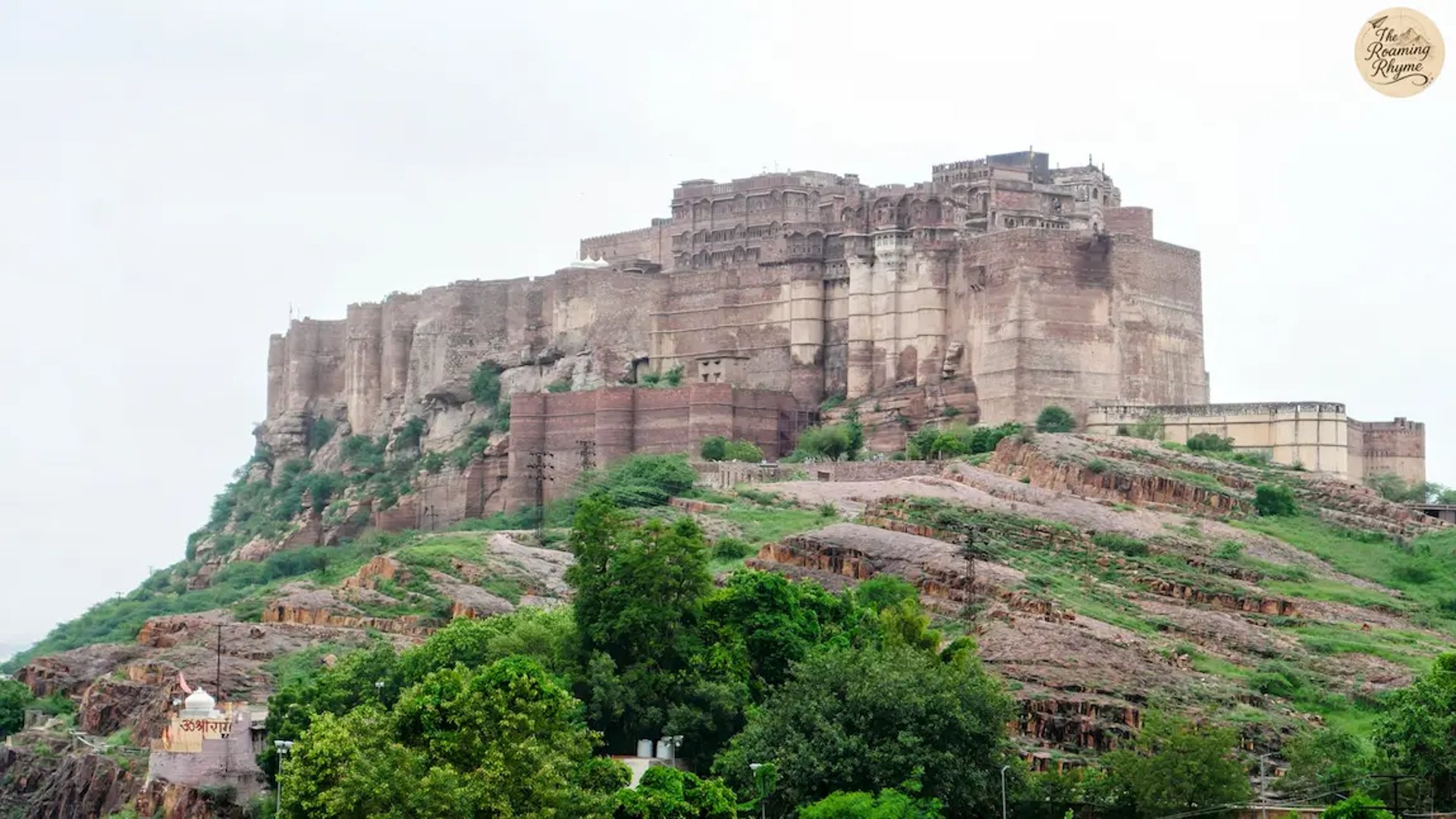
Jodhpur Travel Guide – 2 Days in the Blue City: Forts, Food & Sunsets
Where every street looks like a painting, and every sunset feels like a royal farewell.
About Jodhpur – The Blue Jewel of Rajasthan
In today’s age of glass towers and futuristic skylines, some cities still hold the magic of a bygone era — where history whispers through every wall and culture dances in the streets. Jodhpur is one such city.
Lovingly called the Sun City of Rajasthan, it basks in bright sunshine almost all year round. But it’s equally famous as the Blue City of India, thanks to its maze of indigo-painted houses that glow beautifully under the desert sun. These iconic blue lanes give Jodhpur its postcard-perfect identity and a charm unlike anywhere else in Rajasthan.
Updated on: 18th, Aug 2025
Explored on: July' 2025
Jodhpur as the Gateway to the Thar Desert
Nestled on the edge of the majestic Thar Desert, Jodhpur is often called the Gateway to the Thar — a colourful bloom in the heart of arid sands. Beyond its forts and palaces, Jodhpur offers an authentic taste of desert life: camel caravans on golden dunes, rustic villages where traditions thrive, and sunsets that paint the horizon in fire and gold.
Jodhpur tourism is more than just a checklist of attractions — it’s an experience that lingers long after you’ve left. From the mighty Mehrangarh Fort towering above the city to the grandeur of royal palaces echoing with Rajput history, from lip-smacking Rajasthani food to the warm smiles of locals, this city embraces you like an old friend.
Lose yourself in its bustling bazaars filled with handicrafts and spices, wander through its blue-tinted lanes, or watch the desert sun dip behind ancient walls. Every corner tells a story, every hue holds a memory.
Because the magic of Jodhpur deserves to be experienced to the fullest, this Jodhpur Travel Guide from The Roaming Rhyme shares a thoughtfully crafted 2-day itinerary — covering must-see postcard spots, Instagram-perfect frames, royal heritage, and local flavours. Whether you’re here for history, culture, food, or slow desert charm, this guide will help you make the most of your time in Rajasthan’s Blue City.
Table of Contents
How to Reach Jodhpur – Travel Options for Every Type of Explorer
Getting to Jodhpur, Rajasthan, is as much a part of the experience as being here — whether you arrive soaring over the Thar Desert by air, gliding in on steel rails, or cruising past golden sands and tiny villages by road.
By Air – Jodhpur Airport Connections
Jodhpur Airport (JDH) is small but efficient, connecting the city to major Indian hubs like Delhi, Mumbai, Jaipur, and Udaipur. From the airport, the city centre is barely 5 km away — just a quick ride that gives you your first glimpse of those famous blue-painted houses of Jodhpur. Domestic carriers like IndiGo, Air India, and SpiceJet operate regular flights, making it a convenient choice for short trips.
By Train – Jodhpur Junction Railway Routes
For a more romantic and immersive journey, hop on a train to Jodhpur Junction Railway Station. Well-connected to cities such as Delhi, Jaipur, Jaisalmer, and Ahmedabad, the railway route lets you watch Rajasthan’s landscapes transform — from barren stretches to pockets of vibrant village life. Popular trains include the Mandore Express, Suryanagari Express, and the Delhi-Jodhpur Intercity Express.
By Road – Scenic Drives & Bus Options
If you love long drives, the roads to Jodhpur are well-paved and scenic. Whether you’re coming from Jaipur, Udaipur, Jaisalmer, or even further afield, expect a colourful ride with camel sightings, ancient forts, and rural Rajasthan villages flashing past your window.
By Bus: State-run RSRTC buses and private Volvo coaches operate daily services.
By Car/Taxi: Private cabs can be booked for a direct and flexible journey.
Getting Around Jodhpur – Tuk-Tuks, Rickshaws & Walking
Within the city, auto-rickshaws and app-based cabs like Ola/Uber are your best bet, though the real magic lies in walking through Jodhpur’s narrow blue lanes. For nearby attractions such as Mandore Garden, Umaid Bhawan Palace, or Toorji Ka Jhalra, you can easily hire a tuk-tuk or private cab. Still, at least a part of your Jodhpur trip should be on foot — it’s the only way to truly feel the heartbeat of the Blue City.
Best Time to Visit Jodhpur – Seasonal Travel Guide for the Blue City
Jodhpur, Rajasthan, is a destination that shines year-round, but certain months bring out its most magical side. Choosing the best time to visit Jodhpur depends on whether you want pleasant sightseeing weather, fewer crowds, or festival vibes.
October to March – The Perfect Season for Sightseeing
This is when the Sun City is at its absolute best. Winter in Jodhpur isn’t freezing cold — instead, it offers pleasant sunny days and cool evenings, perfect for exploring Mehrangarh Fort, wandering the blue streets of Jodhpur, or enjoying rooftop dinners under a starlit sky.
Average Temperature: 7°C to 25°C
Why Visit: Ideal for sightseeing, photography, and desert excursions.
💡Travel Tip: Book hotels early for this peak season to secure the best rooftop views of the fort.
April to June – Summers in Jodhpur
Summer in Jodhpur is intense, with daytime temperatures often soaring above 40°C. If you don’t mind the heat — or plan to relax indoors in heritage hotels — you’ll find quieter streets, fewer tourists, and great deals on accommodations.
Average Temperature: 25°C to 42°C
Why Visit: Budget-friendly stays and peaceful tourist spots.
💡Travel Tip: Carry water, wear light cotton clothing, and avoid direct midday sun.
July to September – Monsoon in the Desert
Jodhpur doesn’t get heavy rainfall, but the occasional showers refresh the city, making the indigo-painted houses pop beautifully against the damp stone streets. The desert air feels softer, and the cooler weather is a welcome break.
Average Temperature: 24°C to 35°C
Why Visit: Less crowd, photogenic streets after rainfall.
💡Travel Tip: Keep an umbrella or light raincoat handy for short showers.
Pro Tip – Time Your Visit with Jodhpur’s Festivals
If you want to experience Jodhpur’s culture at its liveliest, plan your trip during:
Rajasthan International Folk Festival (October) – A UNESCO-supported event at Mehrangarh Fort with live folk music, global artists, and cultural performances.
Marwar Festival (October) – Celebrating Rajasthan’s heritage with camel shows, traditional dances, and musical nights.
Where to Stay in Jodhpur – From Royal Palaces to Budget Hostels
Whether you want to live like a Maharaja or stretch your budget while soaking in fort views, Jodhpur offers accommodations for every kind of traveller. Choosing the right stay can completely transform your Jodhpur travel experience — from luxury palace hotels to backpacker hostels with rooftop sunsets.
Luxury – Live Like Royalty in Jodhpur
If you’re ready to splurge, Jodhpur’s heritage hotels are more than just places to sleep — they’re living pieces of history.
Umaid Bhawan Palace – One of the most luxurious hotels in the world, part royal residence, part museum. Expect marble corridors, manicured Mughal-style gardens, vintage car collections, and impeccable service.
RAAS Jodhpur – A boutique luxury hotel that fuses traditional haveli architecture with sleek modern comforts, complete with an infinity pool and uninterrupted views of Mehrangarh Fort.
Ajit Bhawan Palace – Known as India’s first heritage hotel, offering a regal ambience, lush courtyards, and candlelit dinners under the stars.
💡 Pro Tip: Book early if visiting during the Rajasthan International Folk Festival or the Marwar Festival, as these hotels get sold out months in advance.
Mid-Budget – Comfort with Heritage Charm
For travellers who want comfort without overspending, Jodhpur’s boutique hotels and restored havelis offer the perfect balance.
Ratan Vilas – A colonial-era haveli with beautifully furnished rooms and serene gardens.
The Arch Boutique Home Stay – Stylish, intimate, and located close to Jodhpur’s major attractions.
Devi Bhawan – A peaceful heritage stay with lush lawns and vintage interiors, ideal for couples and families.
These stays often come with Rajasthani home-style breakfasts, warm hospitality, and convenient proximity to Jodhpur’s blue lanes and bazaars.
Backpacker – Budget-Friendly Hostels & Guesthouses
If you’re a free-spirited traveller looking for affordable stays in Jodhpur, hostels and budget guesthouses are great for meeting fellow travellers.
Zostel Jodhpur – Colourful, lively, and just steps from the Clock Tower Market.
The Hosteller Jodhpur – Chic interiors, social vibes, and a rooftop café with fort views.
Moustache Jodhpur – Laid-back hostel atmosphere with clean dorms and private rooms.
These stays are perfect for digital nomads, solo travellers, and anyone who values experiences over luxury.
Pro Tip – Stay in the Old City for a True Blue Experience
If you want to explore Jodhpur’s blue lanes, bustling Sardar Market, and rooftop restaurants with fort views, stay in the Old City.
Wherever you choose, pick a room with a rooftop or balcony — watching the Mehrangarh Fort glow at night or the sunrise over indigo rooftops is an unforgettable Jodhpur memory.
In the Blue City, morning slowly wakes,
Smiles greet you kindly on narrow lanes.
The Clock Tower stands with spices in air,
Hot Mirchi Vada, Pyaaz Kachori’s flair.
Mehrangarh Fort sings with desert winds,
Toor Ji Ka Jhalra brings cool within.
Umaid Bhawan shines with royal pride,
Stories of kings still live inside.
In Mandore Garden, old rulers sleep,
Sandstone walls their memories keep.
Daal Baati Churma, warm and sweet,
Rajasthan’s hug in every bite you eat.
Mojris tap softly on streets so wide,
Bandhani sarees flow in colors bright.
Each step in Jodhpur feels like a song,
A journey that carries your heart along.


Jodhpur Itinerary Day 1 – Forts & Markets in Jodhpur
Start your Jodhpur itinerary with a hearty breakfast before heading to the city’s grandest icon — Mehrangarh Fort, a towering testament to Rajput glory and one of the top places to visit in Jodhpur. After soaking in its history and panoramic desert views, spend a relaxed afternoon drifting through bustling Jodhpur bazaars, browsing Rajasthani handicrafts, and letting the colours and aromas of the Blue City surround you.
Breakfast at Jalori Gate – A Flavourful Start to Your Jodhpur Trip
Jodhpur is a paradise for food lovers, where every street corner tempts you with snacks and sweets that are as much a part of its identity as its forts and palaces. And there’s no better way to begin your exploration than with a flavour-packed breakfast at Jalori Gate, a lively roundabout in the heart of the city.
Here, food is more than fuel — it’s a love language.
Surya Namkeen – Famous for its spicy Mirchi Vada (chilli fritters) and flaky Pyaaz Kachori, both deep-fried to perfection and bursting with flavour. These are Jodhpur classics you simply can’t skip.
Arora Namkeen – Known for its signature Lahsun Kofta (garlic-potato fritters) and tall, creamy Makhania Lassi, a rich yoghurt-based drink flavoured with cardamom and saffron.
Street-side stalls – Explore smaller vendors serving Nargis Kofta (a beetroot-potato snack) and crispy Daal-Pakwan (a Sindhi breakfast favourite).
💡 Tip: Arrive early in the morning to enjoy these delicacies while they’re fresh and before the crowds roll in.
Once you’ve fuelled up, it’s time to walk off that indulgence with a visit to Mehrangarh Fort, Jodhpur’s crown jewel and one of the most beautiful forts in Rajasthan.
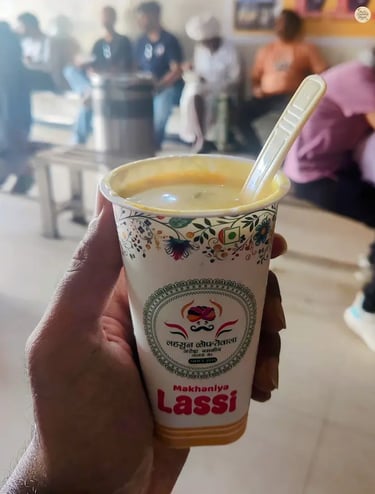

Creamy Makhania Lassi – Jodhpur’s sweet sip of happiness.
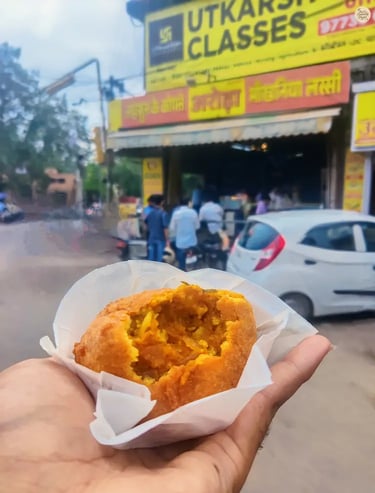

Lahsun Kofta – fiery garlic magic straight from Arora Namkeen’s kitchen.
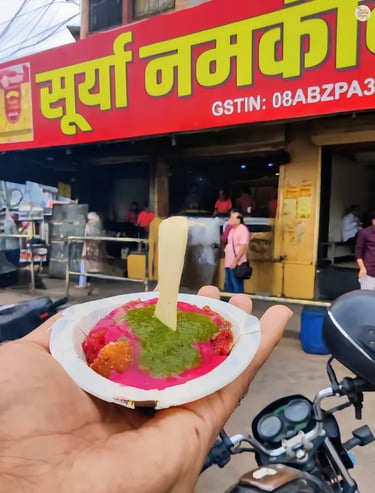

Nargisi Kofta – a royal Rajasthani delight kissed with coriander and mint chutney.
The Period Rooms – Palaces Within a Palace
Take a tuk-tuk ride in Jodhpur straight to the city’s pride — Mehrangarh Fort, a colossal architectural masterpiece that rises 400 feet above the Jodhpur cityscape, blending seamlessly into the rocky hill it crowns. Built in 1459 by Rao Jodha, this is one of the largest forts in India and among the top tourist attractions in Jodhpur. Its burnished red sandstone walls appear both invincible and hauntingly beautiful, standing as a timeless sentinel over the Blue City of Rajasthan.
Rudyard Kipling once called Mehrangarh Fort “the work of giants”, and when you stand before it, you’ll understand exactly why.
For over five centuries, Mehrangarh Fort was the royal seat of the Rathore rulers of Marwar, guarding their kingdom from atop its commanding perch. Today, it serves as both a living museum of Rajput grandeur and a hub of cultural heritage.
Step inside Mehrangarh Fort and you’re not just walking through stone corridors — you’re gliding through centuries of Marwar’s royal legacy. The fort’s museum is a treasure chest of period rooms, royal galleries, and priceless artifacts, each whispering a story from the Rathore dynasty.
If forts fascinate you, don’t miss my Bikaner travel guide, where the grand Junagarh Fort tells equally royal stories of Rajasthan.
💡Tip: Arrive early to capture the fort in soft morning light, or time your visit for late afternoon when the golden hour bathes its walls in a warm glow.
🎥 Fun Fact: Mehrangarh Fort has graced the big screen, appearing in the Hollywood film "The Dark Knight Rises" — making it as famous in cinema as it is in travel photography.
Mehrangarh Fort – The Citadel of the Sun
Inside Mehrangarh Fort, the Period Rooms transport you into an era of unmatched artistry, luxury, and symbolism. Each chamber has its own personality, telling a different chapter of Marwar’s royal heritage. These rooms aren’t just decorated spaces — they are living museums of Rajput aesthetics and craftsmanship.
Sheesh Mahal
A sparkling chamber where mirror work in Jodhpur catches light like fragments of stars, reflecting off every corner. Painted panels depict beloved Hindu deities — from Lord Krishna lifting Govardhan Hill to Lord Ram and Sita with Hanuman — bringing mythology to life. Above, a 19th-century chandelier hangs under a richly carved wooden ceiling.
The Royal Galleries – Stories in Art & Craft
Mehrangarh Fort’s Royal Galleries are more than just displays — they are living chronicles of Marwar’s royal legacy. Each gallery unveils a different layer of Rajasthani heritage, blending artistry, craftsmanship, and history into immersive experiences.
Howdah Gallery
This gallery houses the silver elephant howdah gifted by Mughal Emperor Shah Jahan to Maharaja Jaswant Singh I — an exquisite moving throne that reflects both Mughal generosity and Rajput prestige. Alongside it are intricately carved ceremonial howdahs, each representing centuries of royal processions and ceremonial grandeur.
Palanquin Gallery
Step into a world of regal travel where ivory-inlaid and gold-gilded palanquins (palkis) once carried queens and noblewomen through the streets of Jodhpur, protected by the purdah system. Each palanquin is a masterpiece of Rajasthani craftsmanship and feminine grace.
Daulat Khana
Known as the Treasury Room, Daulat Khana showcases an unmatched collection of Mughal and Rajput artifacts — from Emperor Akbar’s sword to embroidered royal tents and jewel-encrusted ceremonial items. This gallery spans over 500 years of Rathore dynasty history, merging politics, warfare, and artistry.
Painting Gallery
Home to miniature paintings from the Marwar School of Art, with themes that change periodically. The current highlight, Durbar, depicts a royal gathering in intricate brushwork, giving visitors a vivid glimpse into the court life of Jodhpur.
Textile Gallery
This section showcases royal tents, velvets, brocades, and handwoven carpets that once transformed desert landscapes into mobile palaces. Richly embroidered canopies, flowing drapes, and detailed stitchwork reflect Rajasthan’s mastery of textile architecture.
Arms Gallery
A tribute to Marwar’s warrior spirit, the Arms Gallery houses battle-worn shields, jewel-encrusted daggers, and legendary swords. Each weapon is not only a tool of war but also an example of Rajasthani metalwork and craftsmanship in gold, silver, and steel.
Don’t Miss These Last Stops at Mehrangarh Fort
Before you exit this grand fortress, take a few moments to explore its final treasures. These last stops capture the spirit of Mehrangarh — blending history, devotion, and panoramic views that will linger in your memory long after you’ve left.
📍 Stop at the Mehrangarh Museum Shop for handcrafted souvenirs, books, and art pieces — with proceeds supporting the fort’s preservation.
📍Visit the Chamunda Mata Temple, dedicated to Jodhpur’s guardian goddess. Perched within the fort’s walls, it offers breathtaking panoramic views of the Blue City — an unforgettable final memory before you descend back into the city streets.
Things You Must Try at Mehrangarh Fort
Audio Guide – Hear captivating stories narrated in the voice of the Maharaja himself.
Zip-Lining Adventure – Soar over the fort and its surrounding lakes for a thrilling bird’s-eye view.
Folk Music Shows – Enjoy live Rajasthani folk performances in the courtyards during peak tourist season.
Mehrangarh Fort Timings & Entry Fee
Visiting Hours:
🕘 Daily from 9:00 AM to 5:00 PM
Entry Fees:
Indians: ₹200 per person
Foreigners: ₹600 per person
Students (with valid ID): ₹100 (Indians), ₹400 (Foreigners)
Additional Charges:
Audio Guide: ₹180
Elevator Ride: ₹50
Still Camera: ₹100
Video Camera: ₹200
For the latest updates on tickets, events, and visitor facilities, check the official Mehrangarh Fort website.
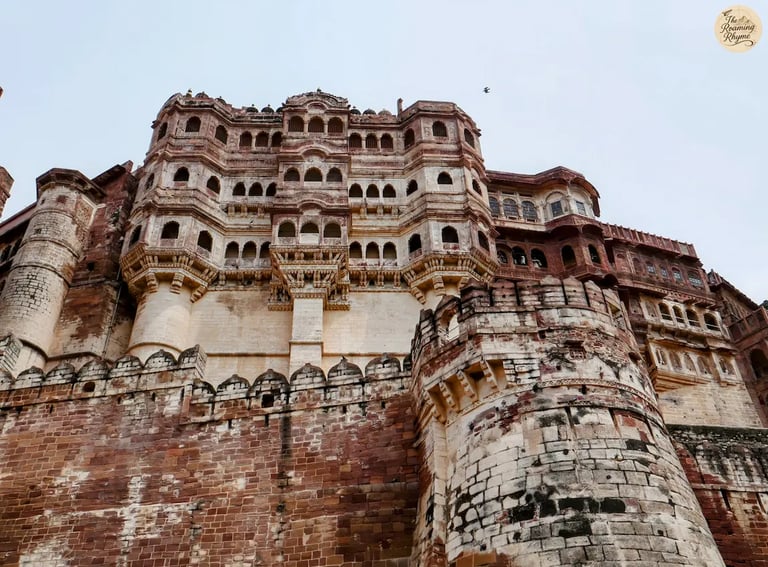

Mehrangarh Fort — where history met Hollywood in The Dark Knight Rises.
Phool Mahal
The most opulent and private royal chamber in Mehrangarh Fort, this gold-filigreed hall glimmers with mirror inlay, stained glass, and intricate floral paintings representing Indian ragas. This was the Maharaja’s pleasure hall, where art and culture bloomed like spring in the desert.
Sardar Vilas
A showcase of traditional Marwar woodwork, where ivory, lacquer, and painted motifs come alive on ancient palace doors and windows — each piece a testament to the kingdom’s artisanal mastery.
Jhanki Mahal
Once a hidden vantage point for royal women, its lattice jharokha windows overlook the fort’s cradle collection — swings once used for royal infants and for deities during festivals. The intricate latticework allowed queens to watch court life without being seen.
Takhat Vilas
A colourful bedchamber painted from floor to ceiling — even the ‘carpet’ is painted. The walls narrate a visual diary of Hindu gods, goddesses, and European muses, blending East and West into a surreal dreamscape.
Dipak Mahal
The fort’s 18th-century political nerve center, where Maharajas and ministers deliberated on matters of war, trade, and governance, shaping the fate of the Marwar kingdom.
Moti Mahal
One of the oldest treasures in Mehrangarh Fort, Moti Mahal features mirror-studded ceilings and lime-polished walls that once reflected the soft glow of oil lamps — making the room shimmer like pearls under moonlight.

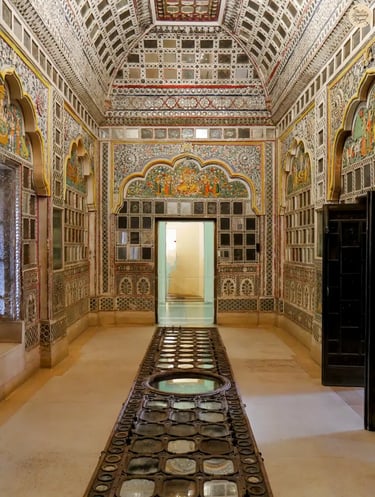
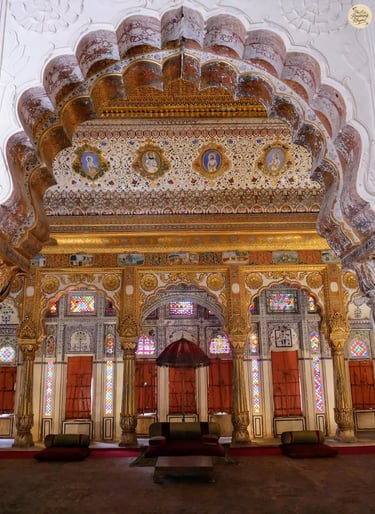

Phool Mahal — where Marwar’s court bloomed in gold.
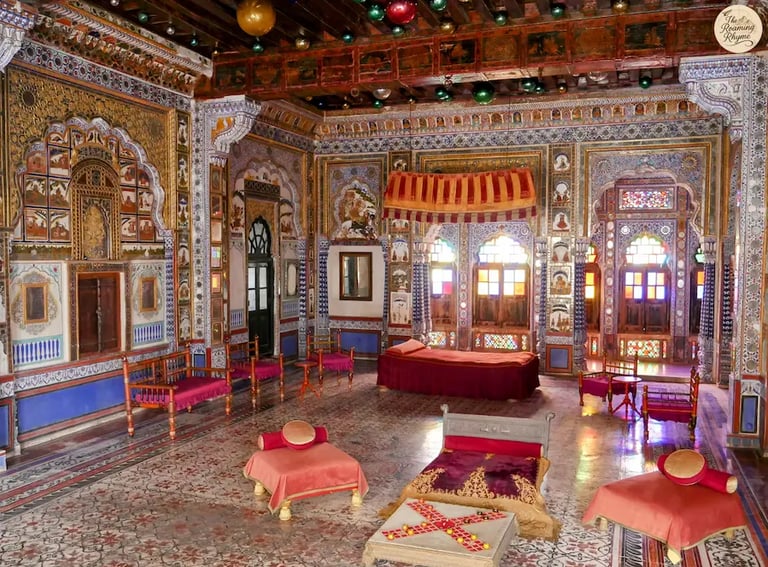

Takhat Vilas — where Rajput tradition met Victorian dreams.
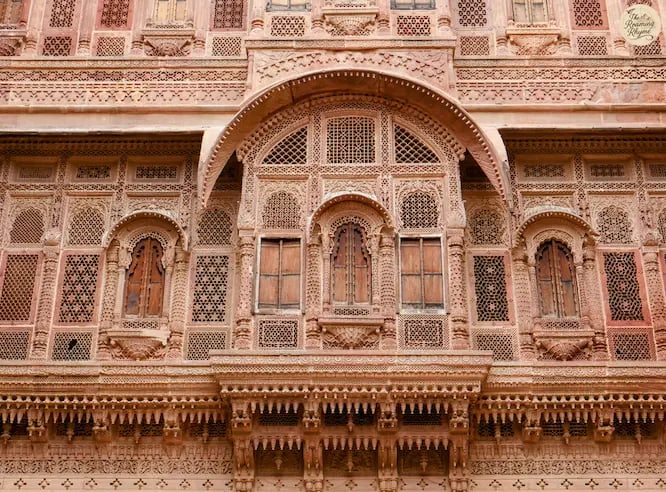

Jhanki Mahal’s red stone jharokhas — where elegance peers through every lattice.
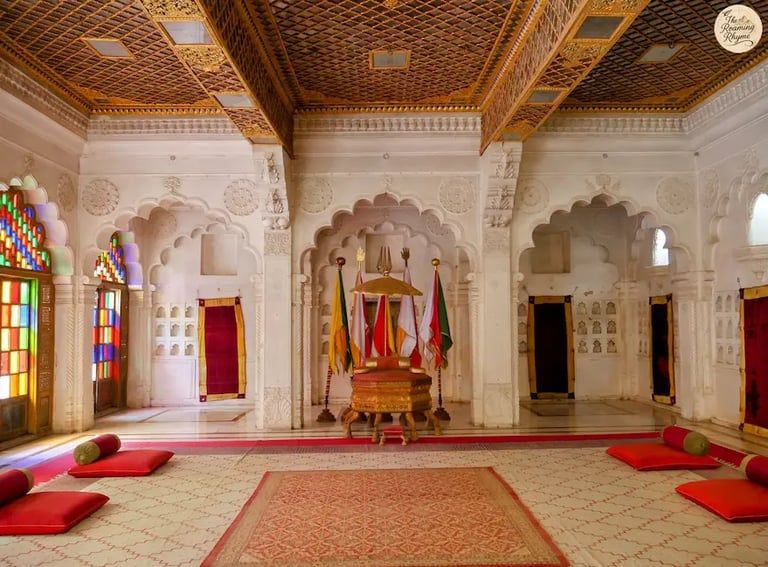

The Pearl Palace of Mehrangarh — a hall of power and beauty.
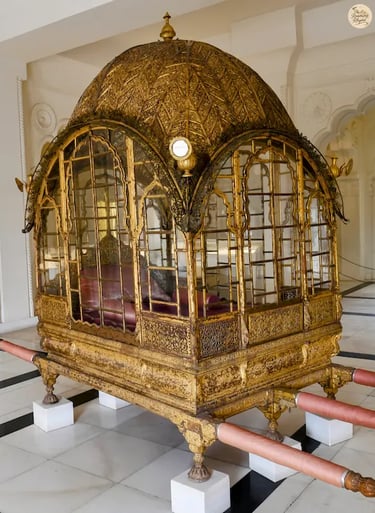

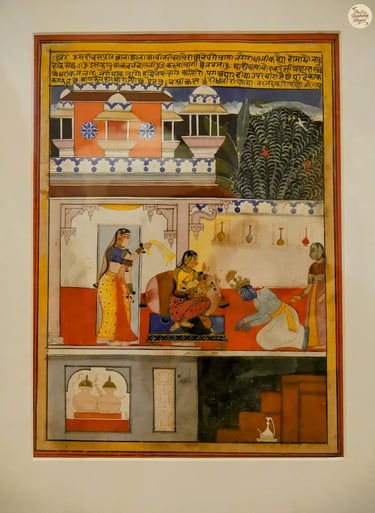

A palanquin of gold — carrying whispers of Jodhpur’s royal past
Every fine brushstroke whispers Jodhpur’s royal tales.
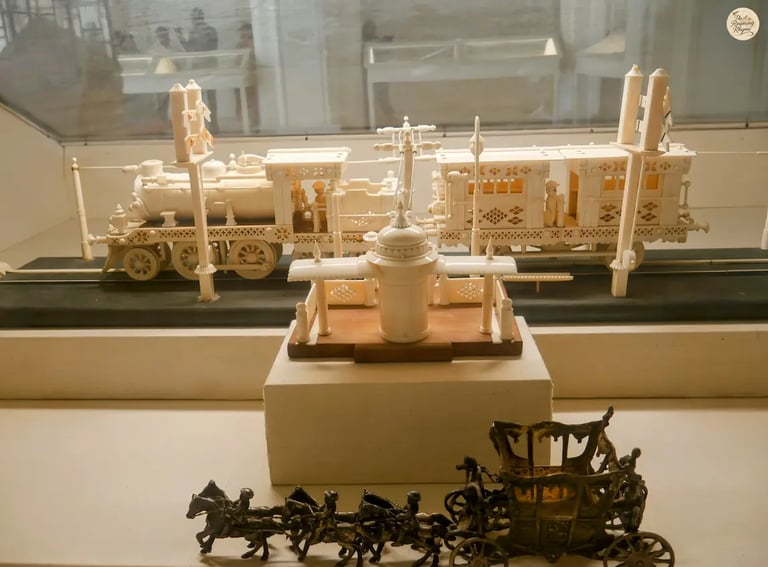

Ivory train model — where craftsmanship meets royal elegance.
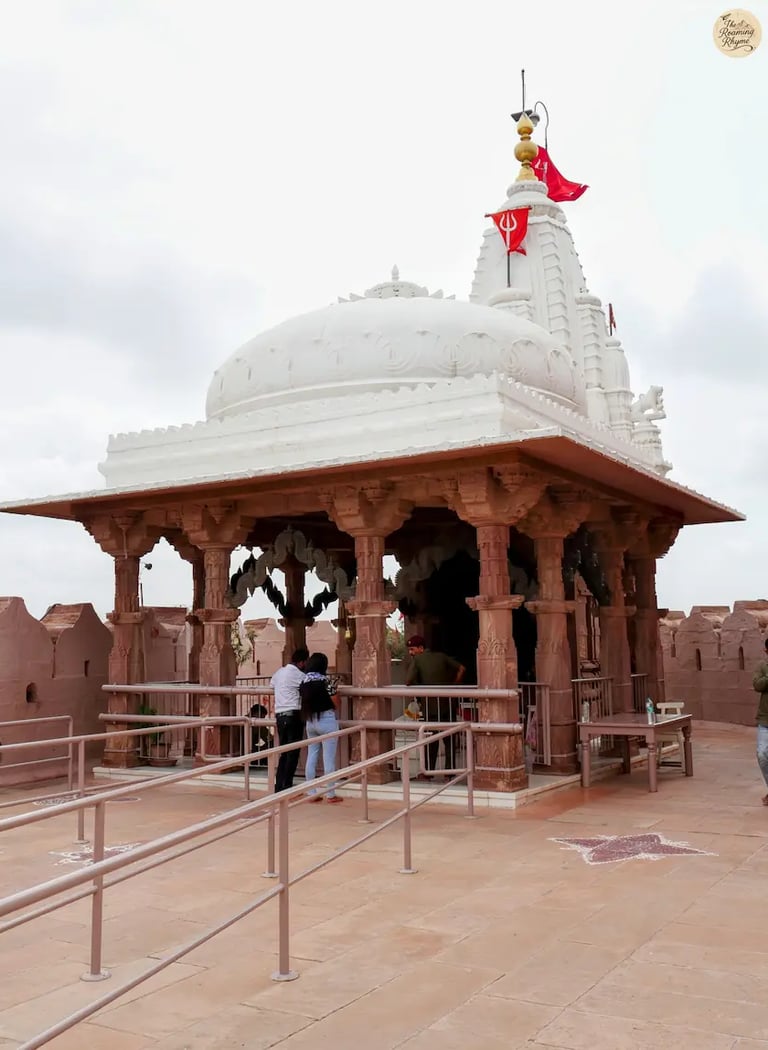

Chamunda Mata Temple — where Jodhpur’s faith finds its eternal guard.
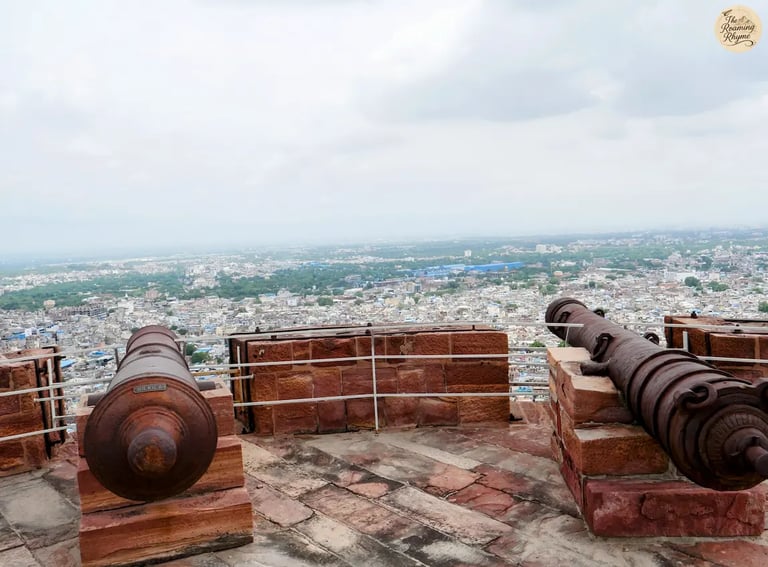

Aligned cannons on Mehrangarh ramparts, guarding the endless Blue City below.
Sheesh Mahal — where mirrors turn walls into stars.
Jaswant Thada – The White Marble Wonder of Jodhpur
After stepping back in time at Mehrangarh Fort, let a tuk-tuk carry you gently downhill to your next stop — Jaswant Thada. Just a few kilometers away, this serene white marble memorial in Jodhpur sits quietly against the rugged desert backdrop, yet holds a charm that draws travelers in instantly.
On the way, your eyes will catch the gigantic equestrian statue of Maharaja Jaswant Singh II, perched high on a cliff and astride his horse, his hand pointing toward Mehrangarh Fort — as if still guiding the city he once ruled.
From the ticket counter, follow a scenic path dotted with gazebos shaded by trees, a tiered garden where flowers bloom in the desert air, and a small lake that mirrors the sky. Along the way, marble cenotaphs stand as silent guardians of history, leading you to the main memorial.
And then it appears — the “Taj Mahal of Marwar”, glowing in flawless Makrana marble. Built in 1906 by Maharaja Sardar Singh in memory of his father, this masterpiece of Rajputana architecture is carved with such finesse that the marble almost glows from within when touched by sunlight. The intricate jali work (lattice screens) casts patterned shadows that dance softly across the floor.
Inside, the main hall feels almost like a temple, echoing with reverence. Rituals honoring the royal ancestors are still performed here, keeping centuries-old Marwari traditions alive. The walls are lined with portraits of Marwar’s rulers, their gazes following you as if silently narrating tales from the past.
Surrounding Jaswant Thada is the Rao Jodha Desert Rock Park, created to restore the native ecology of the land around the fort and memorial. Here, desert flora and fauna thrive — a peaceful escape from the city’s bustle, perfect for birdwatching and photography.
If you’re drawn to temple architecture, my Khajuraho Travel Guide takes you through India’s most iconic UNESCO temples and their timeless carvings.
Jaswant Thada Timings & Entry Fee
Visiting Hours:
🕘 Daily from 9:00 AM to 5:00 PM
Entry Fees:
Indians: ₹50 per person
Foreigners: ₹100 per person
Guide Charges:
1 to 4 Pax: ₹150
5 to 15 Pax: ₹200
16 to 30 Pax: ₹250
31 to 50 Pax: ₹300
📸Best Photography Tip: Visit in the late afternoon when the marble glows warm against the setting sun and the Blue City forms the perfect backdrop.

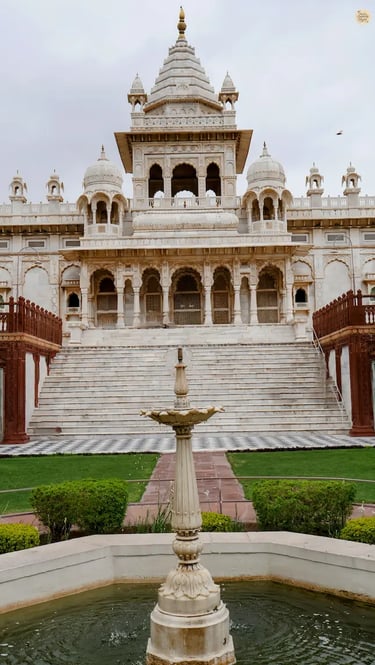
The serne grandeur of Jaswant Thada
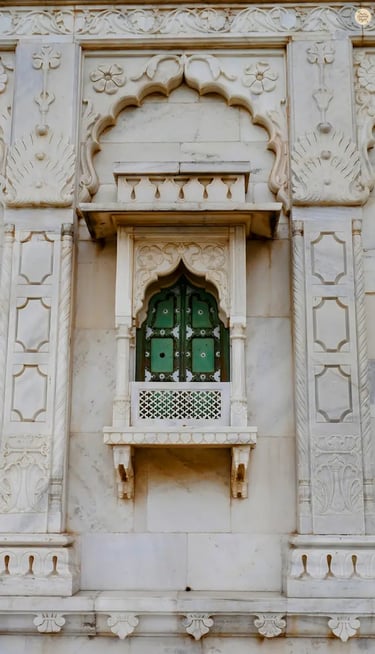

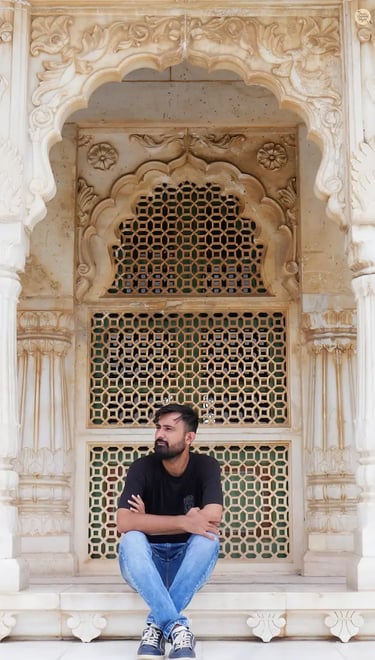

Carved in Marble — a delicate lattice window at Jaswant Thada.
Intricate marble carvings at Jaswant Thada.
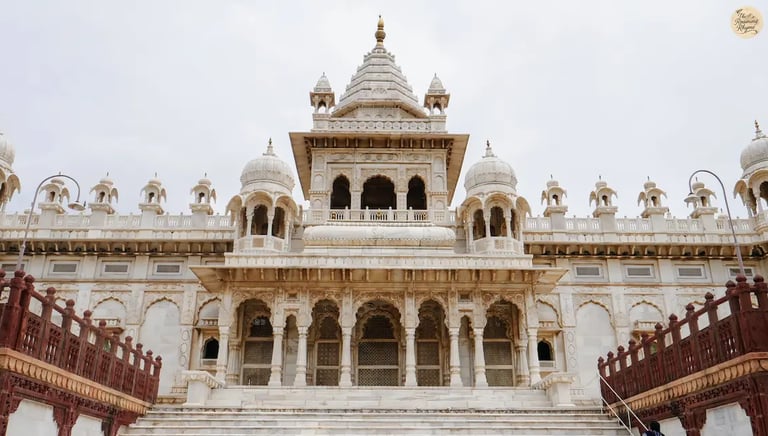

The Taj Mahal of Marwar — Jaswant Thada, where marble whispers eternal grace.
A Unique Lunch at Vijay Restaurant – Malai Roti & Gulab Jamun Sabzi
After exploring the mighty Mehrangarh Fort and the marble beauty of Jaswant Thada, your legs may be weary and your stomach eager for comfort. But this is no time for an ordinary thali — it’s time for a culinary experience unique to Jodhpur.
Head straight into the bustling Katla Bazar, a maze of shops, spice-laden air, and vibrant chaos. Hidden here is Vijay Restaurant, a local legend that has been delighting Jodhpur for generations.
The Star – Malai Roti
Not your everyday roti — this royal dessert is crafted by draining thick malai (milk cream), shaping it into a flatbread, and shallow-frying it in pure desi ghee until golden. It’s then soaked in warm saffron-infused chashni (sugar syrup) and topped with chopped pistachios and almonds. The result? A dessert disguised as bread — rich, indulgent, and unlike anything you’ve tasted before.
The Surprise – Gulab Jamun Ki Sabzi
A true Rajasthani food innovation — here, the soft, syrupy gulab jamuns you know as dessert are transformed into a savory curry. The sweetness of the jamun is balanced with fragrant spices and a gentle heat from green chilies, creating a flavor profile that’s unforgettable.
Every bite at Vijay Restaurant is a journey — a mix of heritage recipes, desert ingenuity, and Jodhpur’s love for culinary surprises. You’ll leave not just full, but with a newfound respect for Rajasthani creativity in the kitchen.
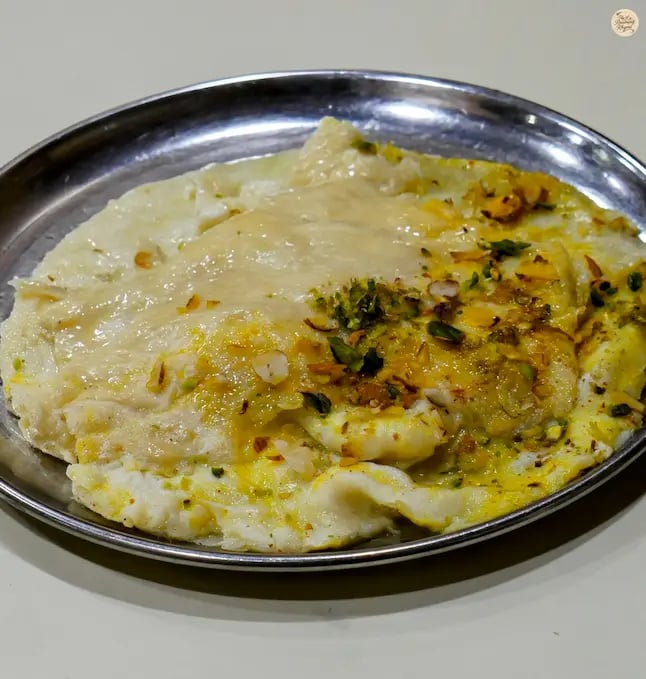

Sweet layers of Malai Roti at Vijay Restaurant — Jodhpur’s dessert with a royal touch.
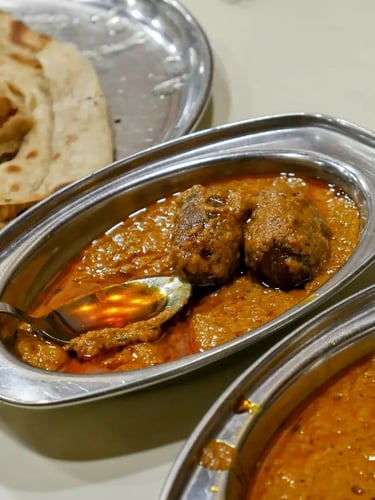

Gulab Jamun ki Sabji — Jodhpur’s royal twist where sweet turns into a savory delight.
Evening Market Walks – Clock Tower, Sardar Bazaar & More
After a day of exploring Mehrangarh Fort, admiring the white marble elegance of Jaswant Thada, and indulging in a hearty lunch at Katla Bazar, it’s time to slow the pace. As the afternoon sun softens and the desert breeze carries hints of spice, Jodhpur’s old markets invite you for a leisurely stroll.
Explore Jodhpur’s Traditional Markets
Since you’re already in the heart of the Blue City, wander deeper into its ornate market alleys — each lane a living story, each shop a piece of Marwar’s rich heritage.
Sojati Gate Market – Famous for Bandhej/Bandhani fabrics in vibrant reds, yellows, and pinks. These tie-and-dye masterpieces swirl like captured sunsets. Look for block-printed textiles that showcase Rajasthan’s folk artistry.
Mochi Bazaar – The go-to place for handcrafted mojaris or juttis — traditional leather footwear once worn by royals.
Lakhara Bazaar – A treasure trove of glass and lacquer bangles, their shimmering colors catching the light like desert jewels.
Tripolia Bazaar – Known for wooden puppets, intricately carved figurines, and fine leather goods, including bags and diaries made by skilled artisans.
Clock Tower & Sardar Market – The spice capital of Jodhpur, with turmeric as golden as the desert sands, fiery red chilli powders, and fragrant Rajasthani masala blends. Perfect for culinary souvenirs.
📸 Tip for Travelers: Even if you don’t plan to shop, Jodhpur’s markets are a feast for the senses — full of colors, scents, and the lively calls of shopkeepers whose families have been here for generations.
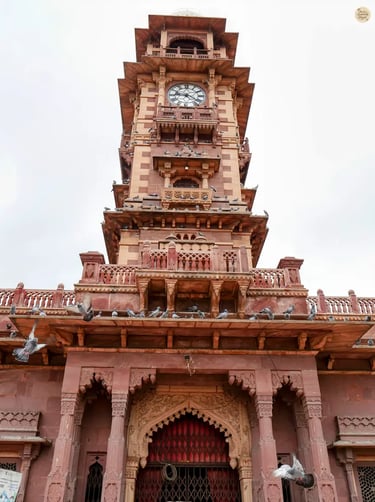

Jodhpur’s iconic Clock Tower stands tall as the heart of Sardar Market.
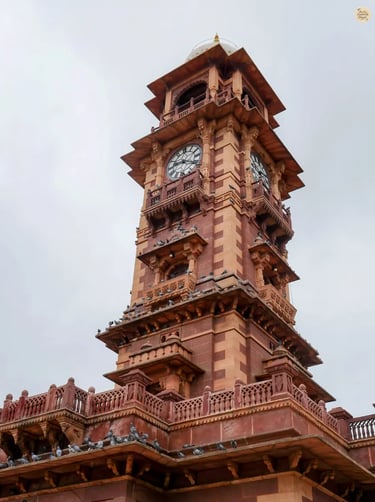

Timeless charm of Jodhpur’s Clock Tower watching over the heart of Sardar Market.
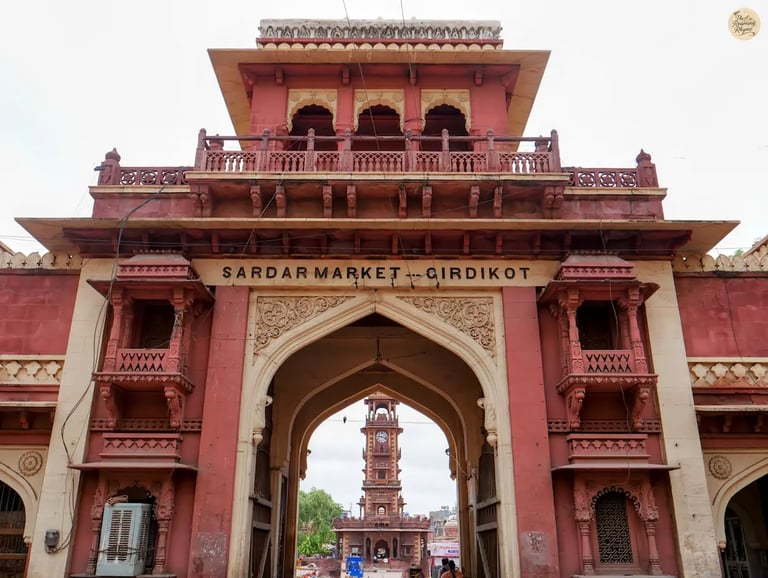

Framing Jodhpur’s charm — the entry gate of Sardar Market with the Clock Tower rising through its arch.
Dinner with a View – Rooftop Restaurants in Jodhpur
As the sun sets and your first day in Jodhpur draws to a close, there’s no better ending than dining at a rooftop restaurant with the mighty Mehrangarh Fort illuminated in golden light.
Popular Rooftop Restaurants in Jodhpur:
Indigo Restaurant – A culinary gem offering panoramic fort views and often ranked among the top dining spots in Jodhpur.
Dylan Café – Featured on Incredible India’s “must-bookmark” list for its romantic rooftop ambiance and candlelit dinners.
Café Laalten – A cozy café known for its peaceful ambiance and charming rooftop setting, rated among the best in Jodhpur.
Indique Restaurant & Bar – A rooftop dining experience with candlelit elegance and a delicious menu that includes Rajasthani classics like Laal Maas and Gatte Ki Sabzi.
Intimate & Artistic Dining Options:
Sam’s Art Café – A vintage boutique café with sculptures and artwork you can purchase, perfect for a cozy evening.
Jhankar Choti Haveli – A charming heritage eatery with traditional décor and a warm, intimate vibe — ideal for relaxed conversations under the stars.
Whether you choose a traditional Rajasthani thali, rich curries, or sizzling kebabs, the fort in the backdrop makes every bite feel unforgettable.
After dinner, head back and get a good night’s sleep — because tomorrow will take you through Jodhpur’s famous blue lanes, a royal palace, and a peaceful garden with ancient temples.
Jodhpur Itinerary Day 2 – Waking Up in the Blue City
The second morning in Jodhpur rises with soft desert air and golden light spilling over its indigo-painted lanes. Temple bells echo in the distance, and the streets slowly stir to life.
Today’s journey flows from narrow blue alleyways that feel like a painted maze, to the grandeur of a royal palace, and the quiet grace of ancient temples and gardens. From sunrise to sunset, the Blue City offers a perfect blend of color, culture, and timeless charm.
Lace up your shoes, grab your camera — Day 2 is where Jodhpur’s soul truly unfolds.
Morning Walk in the Blue Lanes of Jodhpur
Wake up with the first rays of the sun, when the city is still stretching and yawning. This is the best time to experience the iconic blue houses that gave Jodhpur its famous nickname — The Blue City.
In the early hours, Jodhpur’s narrow lanes glow in soft light, walls brushed in every shade of blue — from pale sky to deep indigo. There’s a peaceful hush, broken only by the sound of temple bells, the distant hum of morning prayers, and the gentle chatter of locals preparing for the day.
As the city wakes, the lanes fill with life — cows wander lazily, dogs nap in shaded corners, children turn streets into playgrounds, and the occasional motorcycle hums past. This charming rhythm is best enjoyed before the desert sun climbs high.
Self-Guided or Guided Walking Tour?
You can explore these lanes on your own, but a guided Blue City walking tour is worth it. Local guides know the maze-like bylanes by heart, leading you to hidden treasures — secret courtyards, blue-painted temples, and photogenic doorways that you might otherwise miss.
If you prefer going solo, head toward Navchowkiya and City Police Chowki — neighborhoods where blue houses cluster most densely. Don’t hesitate to ask locals (or playful kids) for directions — hospitality is woven into the fabric of Marwari culture.
A Photographer’s Dream
Not every house in Jodhpur is blue, even in these areas, but the theme runs deep enough to make every turn picture-perfect. With Mehrangarh Fort peeking over rooftops and the sunlight bouncing off painted walls, these lanes create one of the most photogenic scenes in Rajasthan.
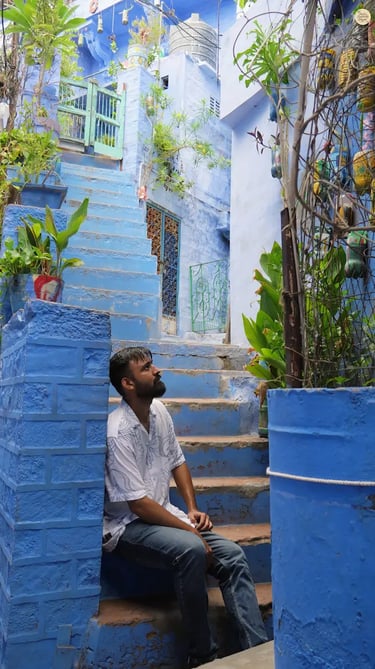

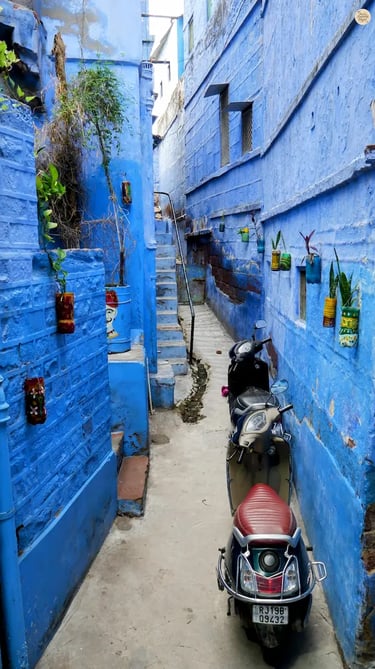

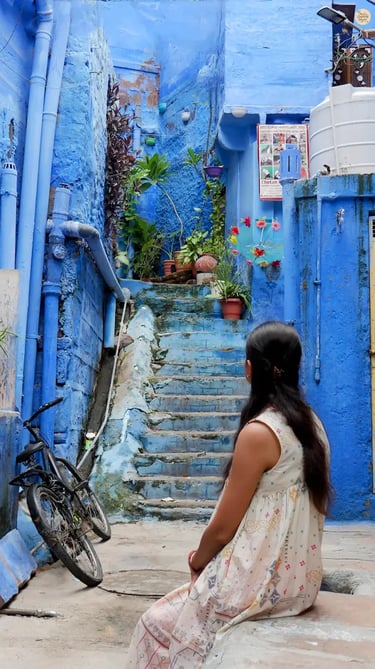


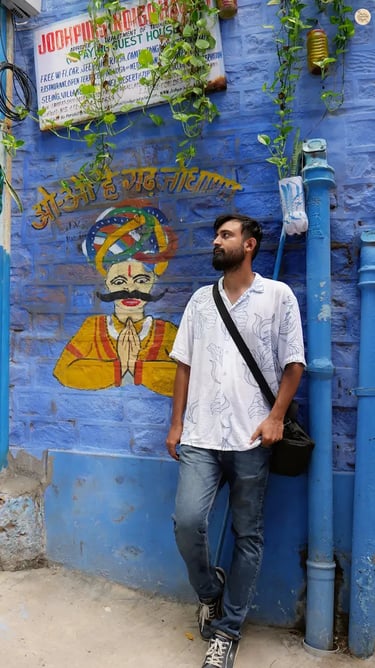
Wander into Jodhpur’s blue lanes, where every turn paints the city’s soul brighter.
In the heart of the Blue City, these indigo lanes whisper heritage, peace, and timeless charm.
Relax, breathe, and take in the Blue City’s charm.
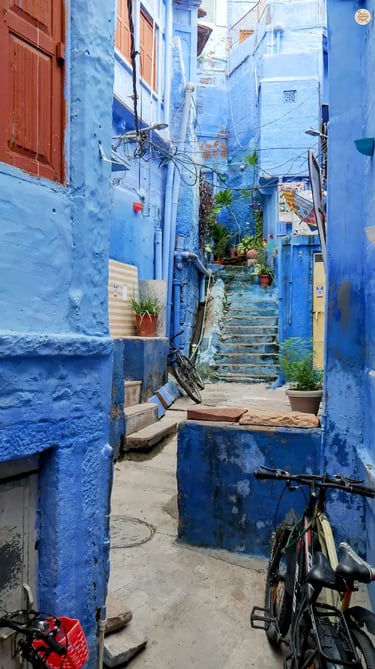

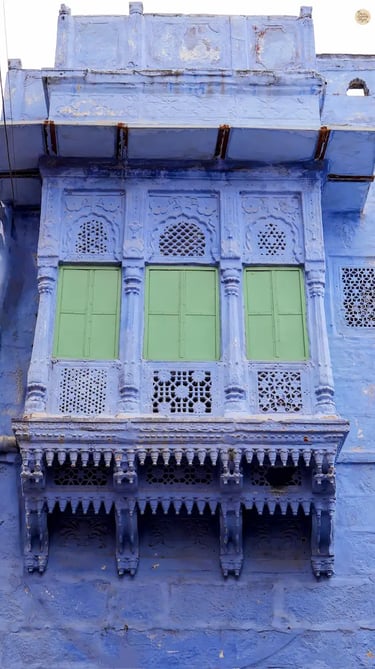

A vibrant mural of a Rajasthani man on Jodhpur’s blue wall — art meeting tradition in the Blue City.
Jodhpur’s blue lanes —often compared to Chefchaouen in Morocco.
A blue-painted jharokha in Jodhpur’s old city, blending royal elegance with timeless charm.
Breakfast at Clock Tower – Samosa, Lassi & Jalebi
After your morning wander through Jodhpur’s dreamy blue lanes, your legs might ask for a rest, and your stomach will surely start calling. And in Jodhpur, breakfast isn’t just a meal — it’s a royal welcome served on the streets.
Forget fancy dining rooms and starched napkins. The real taste of Jodhpur lives in its bustling old-city markets, where narrow lanes hum with the clink of steel plates, the hiss of hot oil, and the chatter of locals sharing their morning bite. And there’s no better place to start than the Clock Tower (Ghanta Ghar) area — the heart of the city’s street-food scene.
Shahi Samosa – Jodhpur’s Golden Morning Bite
First stop: Shahi Samosa, a Jodhpur street food icon. This isn’t your regular roadside snack — the samosa here comes with a royal twist. The filling blends mashed potatoes with aromatic spices and a surprise crunch of dry fruits, making every bite rich and festive.
The shop has been serving these golden beauties for decades, and the queue outside speaks for itself. The cooks start before sunrise, working over a giant kadhai to fry samosas that are bigger, crispier, and more indulgent than anything you’ve tried before.
Shri Mishrilal Hotel – The Legendary Makhaniya Lassi
Next, cool down with a sweet treat at Shri Mishrilal Hotel — home to the famous Makhaniya Lassi. This isn’t something you gulp down — it’s an experience you savor with a spoon. Made with thick, sweetened curd, a hint of cardamom and kewra, and topped with a buttery layer that melts slowly on your tongue, this drink-dessert is a Jodhpur breakfast tradition.
Motu Jalebi Wala – Sweet History in a Spiral
If you still have room (and trust me, you should), follow your nose to Motu Jalebi Wala — a 150-year-old sweet shop tucked into a quiet lane. The smell of frying sugar greets you before the shop comes into view. Here, jumbo jalebis are made fresh in pure ghee, crispy on the outside and dripping with syrup inside.
The “Motu” in the name isn’t just about their generous size — it’s a nod to the jovial founder, a man who believed sweets should make both your heart and your eyes light up. With no artificial coloring, just pure sweetness, these jalebis are a heritage treat worth seeking out.
Rajasthan’s culinary journey doesn’t stop here — if you’re a foodie, don’t miss Bikaner, another gem of Rajasthan, famous for its namkeen snacks, sweets, and heritage havelis.
The Clock Tower market area isn’t just a breakfast stop — it’s a perfect place for a Jodhpur food walk, where every turn reveals another snack worth trying. Surrounded by Sardar Market, you can also explore spice stalls, textile shops, and handicrafts before continuing your day’s adventure.




Crisp, golden swirls of Jalebi joy at Motu Jalebiwala.
Dawn stillness at Jodhpur’s iconic Clock Tower.
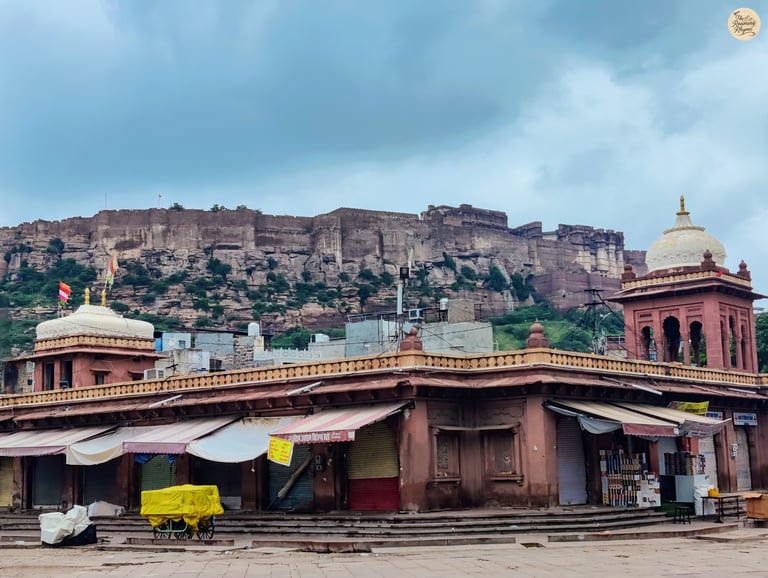

Mehrangarh Fort watches over the calm streets of Sardar Market.
Toorji Ka Jhalra – The Queen’s Stepwell
Steps of history, waters of time — Toorji ka Jhalra reflects Jodhpur’s timeless rhyme.
Where ancient steps meet shimmering waters — the soul of Jodhpur flows quietly at Toorji ka Jhalra.
With your belly full and your heart still buzzing from the flavors of the Clock Tower market, take a slow walk through its lively courtyard. Slip out from the back gate, weave your way through a few maze-like lanes, and soon the market’s chatter will fade into a quiet pocket of the old walled city.
Here, tucked between twisting alleys and centuries-old havelis, lies one of Jodhpur’s hidden gems — Toorji Ka Jhalra, a breathtaking 18th-century stepwell that whispers stories from the city’s royal past.
History of Toorji Ka Jhalra
Built in 1740 AD by Rani Tawarji, the queen of Marwar and wife of Maharaja Abhay Singh, this 300-year-old marvel is a tribute to Rajasthan’s traditional water architecture. In an era when stepwells were lifelines in the desert, this one stood out for its ornate design and engineering brilliance.
Architecture & Design
Descend its seven tiers of sandstone steps, each tier leading you deeper into history until you’re standing at the edge of water believed to be 300 feet deep.
Look closely, and you’ll notice:
Delicate stone carvings along the stairways.
Marble arches frame the views.
Animal-shaped water spouts — cows and lions — that once channeled water into the well.
Statues of Hindu deities quietly seated along the steps, offering spiritual protection.
Above, the old jharokas (viewing balconies), once lit by oil lamps, now offer a different thrill — in summer, daring local boys leap from them into the cool green water below.
Whether you’re a history enthusiast, architecture lover, or travel photographer, Toorji Ka Jhalra is pure magic. Watch how sunlight dances over the honey-gold stone, how shadows stretch across ancient steps, and how the water mirrors the cloud-strewn Rajasthani sky.
Best of all, it’s still a living monument — not roped off as a sterile museum piece, but alive with the energy of locals who treat it as both heritage and hangout.
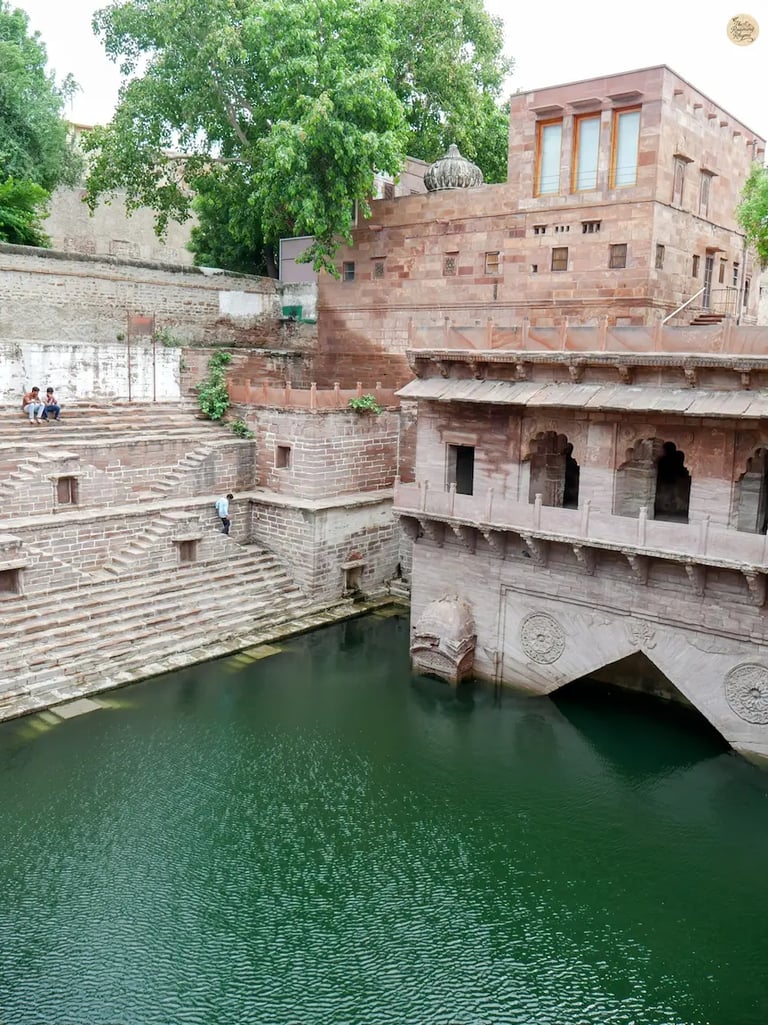

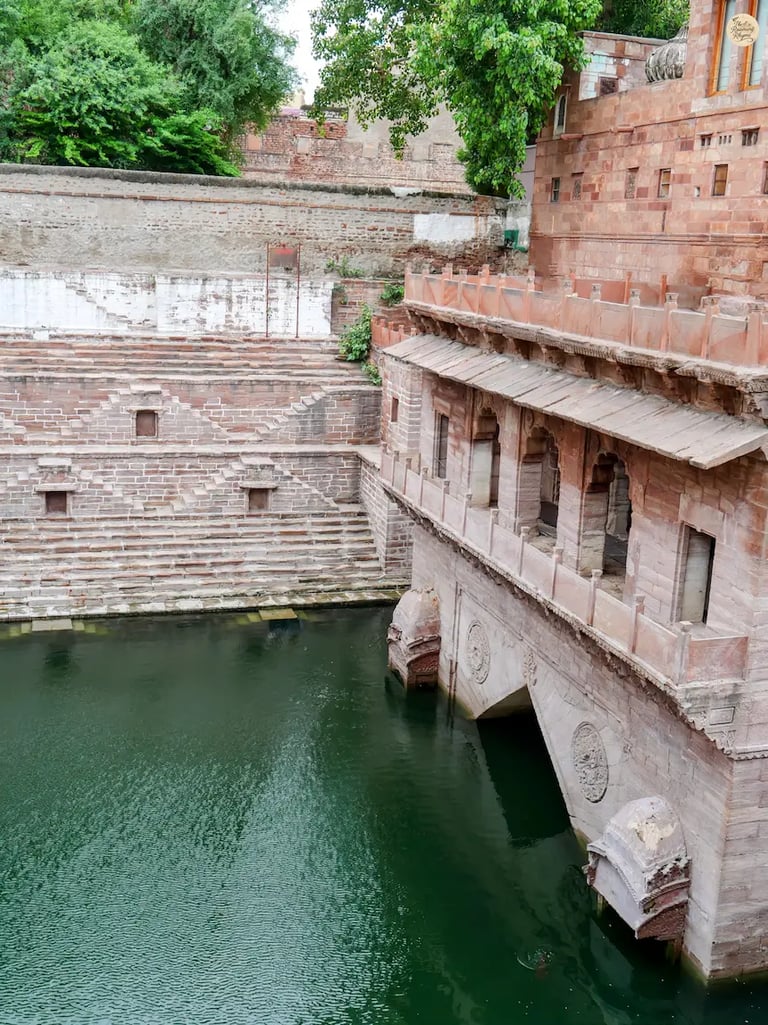

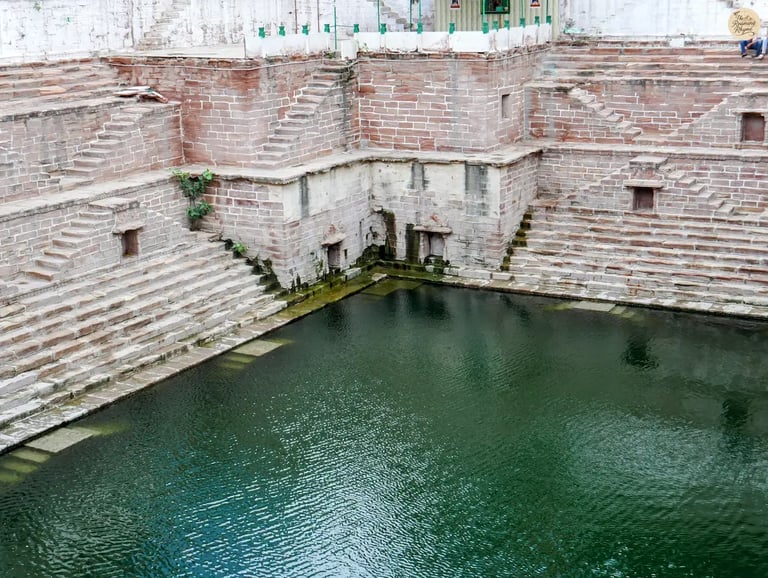

Every step tells a story, every ripple holds a memory — Toorji ka Jhalra, the hidden jewel of Jodhpur.
Umaid Bhawan Palace – Museum & Royal Hotel
After soaking in Jodhpur’s vintage charm and wandering its centuries-old streets, step into a different world — one of opulence, grandeur, and royal dreams. No place captures this spirit better than Umaid Bhawan Palace, the architectural crown jewel of the Blue City.
Perched proudly on Chittar Hill, one of the city’s highest point, this golden-yellow sandstone masterpiece was built between 1928 and 1943 by Maharaja Umaid Singh. What began as a visionary project during a severe famine became a marvel of Rajasthani heritage architecture, spread over 26 acres of lush gardens. With 347 rooms, sweeping marble corridors, green velvet lawns, and treasures from the royal collection, Umaid Bhawan isn’t just a palace — it’s a living chronicle of the Rathore dynasty.
The Three Faces of Umaid Bhawan Palace
Umaid Bhawan Museum – Open to the public, showcasing priceless relics of Jodhpur’s royal heritage.
Taj Umaid Bhawan Palace Hotel – A luxurious five-star heritage hotel run by the Taj Group, where guests can live like modern-day Maharajas.
The Royal Residence – Home to Maharaja Gaj Singh II, grandson of Maharaja Umaid Singh. On rare days, visitors might even catch a glimpse of him.
Inside the Umaid Bhawan Palace Museum
Step inside and discover a royal treasure chest:
Elegant Cutlery – Glass and porcelain plates, wine glasses, and dining ware once used at regal feasts.
Rich Paintings – Miniatures, portraits, and wall murals depicting the royal family, mythology, and historical events.
Historic Weapons – Swords, shields, and rare pistols from the royal armory.
Exquisite Textiles – Embroidered shawls, turbans, and ceremonial garments.
Unique Trophies – Elephant-foot stools, tiger-skin rugs, and a royal flag gifted by Queen Victoria.
Vintage Clocks – Antique timepieces from around the globe.
Classic Cars – An awe-inspiring collection of Rolls-Royce, Mercedes-Benz, and other vintage beauties gleaming like they just rolled out of a royal garage.
Inside, every corridor echoes with history — lofty ceilings, hunting trophies, and sunlit courtyards that have seen generations pass. Outside, the palace gardens stretch endlessly, framing the dome like a scene from a royal painting.
Visitor Information
Entry Fee (Museum): ₹30 (Indians), ₹100 (Foreigners), ₹10 (Children 5–11 years)
Timings: Open daily, 10:00 AM – 4:30 PM
Whether you’re drawn to heritage architecture, fascinated by royal lifestyles, or simply looking for one of the most Instagrammable places in Jodhpur, Umaid Bhawan Palace is a must-visit. From the glow of sunrise over its golden dome to the warm hues of sunset on its gardens, this palace makes you pause… and dream a little bigger.
If you enjoy exploring royal artistry, don’t miss Hampi’s royal complex, another UNESCO World Heritage Site filled with palaces and temples.

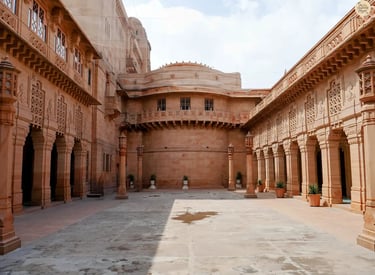
Grace in stone — the red sandstone courtyard glowing in heritage charm.
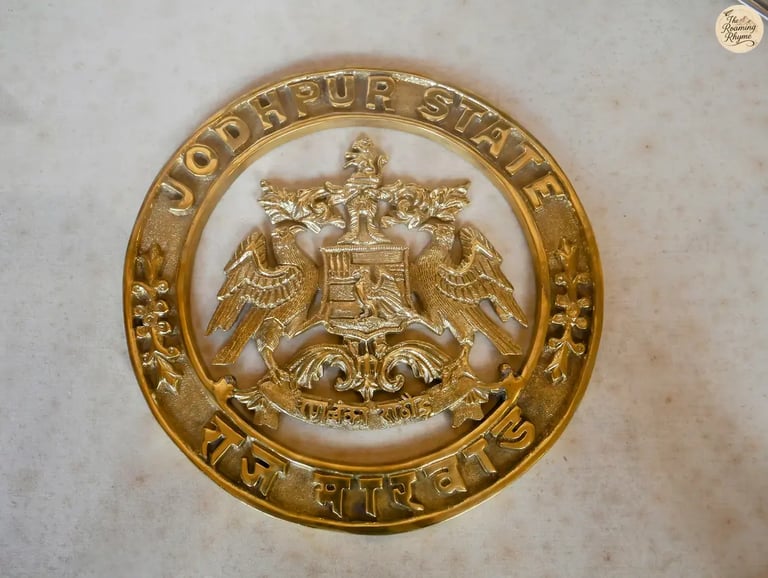

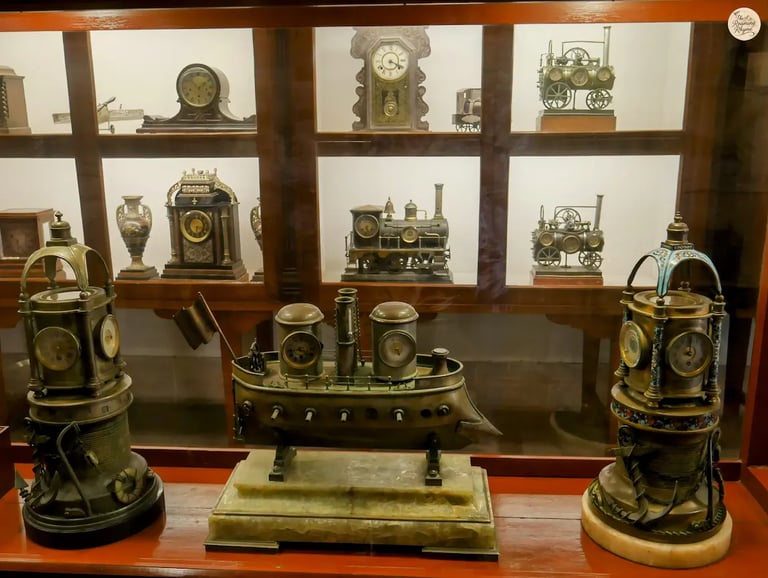

The royal seal of Jodhpur’s legacy
Timeless treasures — antique clocks gifted to Jodhpur’s royals.
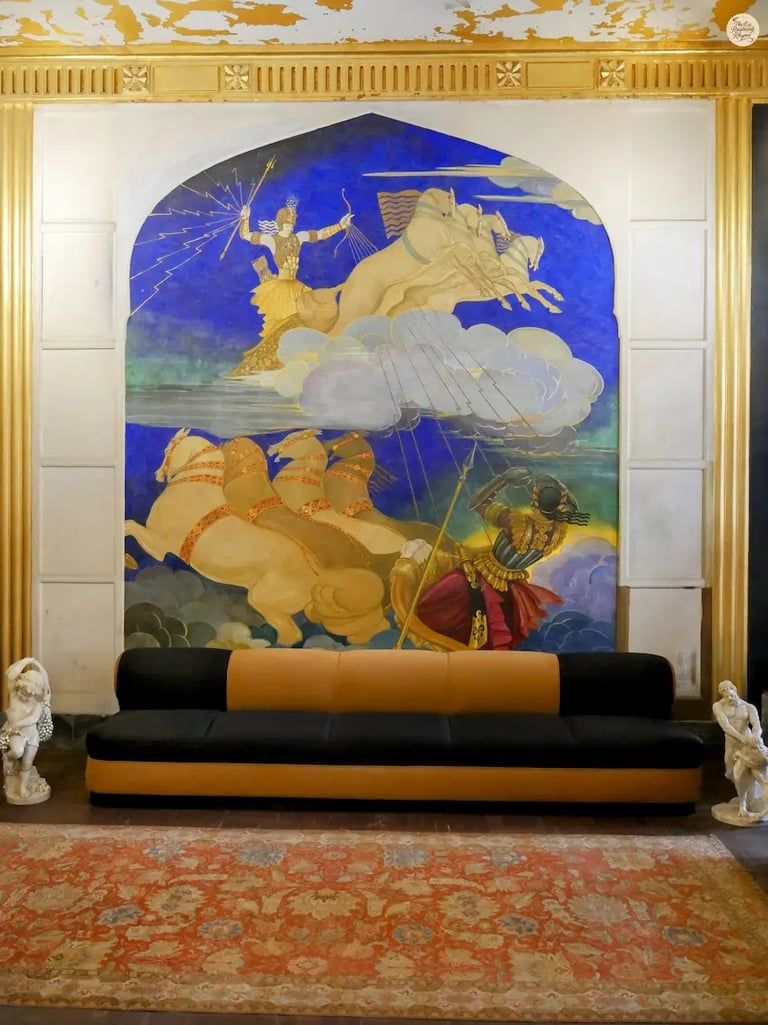



Ram–Ravana war reimagined with royal brushstrokes of Jodhpur.
The tale of Lava–Kusha and Sita’s return to Mother Earth captured on canvas.

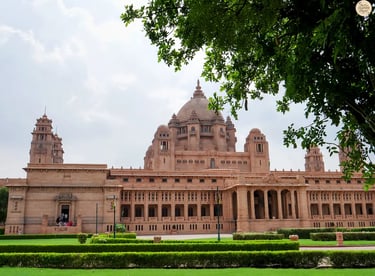
Lunch at Gypsy Restaurant – Rajasthani Thali Experience
By the time you step out of Umaid Bhawan Palace, the afternoon sun will already be bathing Jodhpur in golden light — and your appetite will be calling. There’s no better way to answer than with Rajasthan’s most iconic dish that we haven’t yet enjoyed on this journey — the legendary Dal Baati Churma.
For the ultimate feast, head to Gypsy Restaurant in the Sardarpura area of Jodhpur — a foodie landmark loved by locals and travelers alike. Here, the jumbo Rajasthani Thali isn’t just a meal; it’s a royal banquet on a single plate. Imagine being served not two or three dishes, but 31 different delicacies, each bursting with authentic flavour, colour, and tradition.
What’s on the Plate?
Breads & Staples
Earthy, smoky Baati (baked wheat dumplings)
Nutritious Bajre ki Roti (millet bread)
Buttery Naan and flaky Parathas
Golden, crisp Pooris
Curries & Vegetables
Comforting Yellow Dal and Green Gram Dal
Zesty Chickpea Curry
Tangy Kadi (yogurt-based curry)
Spicy Gatte ki Sabzi (gram flour dumplings in gravy)
Seasonal specials like Kair-Sangri ki Sabzi, Capsicum-Tomato Curry, and Cheese & Green Peas Curry
Snacks & Sides
Crunchy Pakodi and Ganthiya
Khaman Dhokla served with fried green chilies
Fresh salad of onion, lemon, cucumber, and tomato
Sweet & tangy chutneys plus spicy green coriander chutney
Desserts
Rich Gajar ka Halwa (carrot pudding)
The beloved Churma Ladoo, a sweet crumble rolled into perfect bites of bliss
Eating here isn’t just lunch — it’s a culinary tour of Rajasthan on a single thali. Every bite tells a story, from the smoky aroma of Baati to the slow-cooked sweetness of Churma. Whether you’re a first-time visitor to Jodhpur or a returning traveller, Gypsy’s Rajasthani Thali will leave you full, happy, and already planning your next visit.


A royal feast on a single plate at Gypsy, Jodhpur.
Mandore Garden – Cenotaphs, Temples & Legends
After a royal feast at Gypsy Restaurant, it’s time to slow the pace and step into another chapter of Jodhpur’s history — the serene Mandore Garden. Just a short drive from the city centre, this sprawling heritage site was once the capital of the Marwar kingdom before Jodhpur was founded. Today, it’s a poetic blend of ancient architecture, lush greenery, and blooming flowers that invites both history lovers and peace seekers.
A Walk Through Royal History
Scattered across the garden are majestic cenotaphs (chhatris), each one a memorial to the kings and queens of Marwar. The most striking is the chhatri of Maharaja Ajit Singh — an ornate red sandstone marvel with carved pillars and soaring spires that glow warmly in the late afternoon sun. Every cenotaph here feels like a silent storyteller, sharing tales of power, legacy, and devotion. Much like the cenotaphs of Orchha, Mandore’s memorials stand as timeless reminders of royal grandeur.
If you love Rajput architecture, you’ll find endless inspiration in the high-pillared halls, intricately carved domes, and ornate memorials that merge artistry with the timeless calm of nature. Shrines dedicated to Hindu deities, like the Kala and Gora Bhairav Temple, add a vibrant splash of colour, with idols that seem almost alive in the gentle daylight. Lovers of heritage art will also appreciate how Mandore’s fine details echo the storytelling brilliance of the temple carvings of Khajuraho.
Nature, Legends & Local Life
As you wander the shaded pathways and pause under ancient trees, you might find curious langurs watching from above — unofficial guardians of the garden. Mandore isn’t just history and beauty; it’s also steeped in myth and legend. Locals believe this was the birthplace of Mandodari, wife of the demon king Ravana from the epic Ramayana. The name “Mandore” is said to be derived from hers, adding a mythical thread to its historic fabric.
Visitor Information
Garden Timings: 8:00 AM to 8:00 PM (daily)
Museum Timings: 9:00 AM to 6:00 PM (Saturday–Thursday; closed Fridays)
Entry Fee: Garden entry is free. Museum entry ₹50 per person.
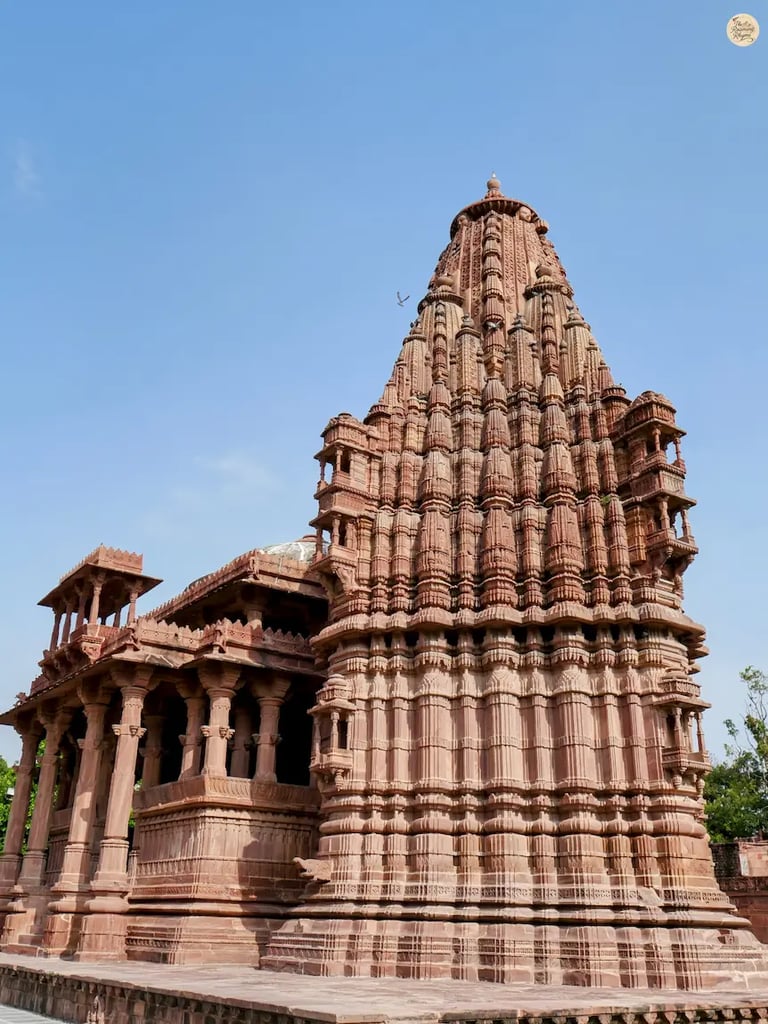

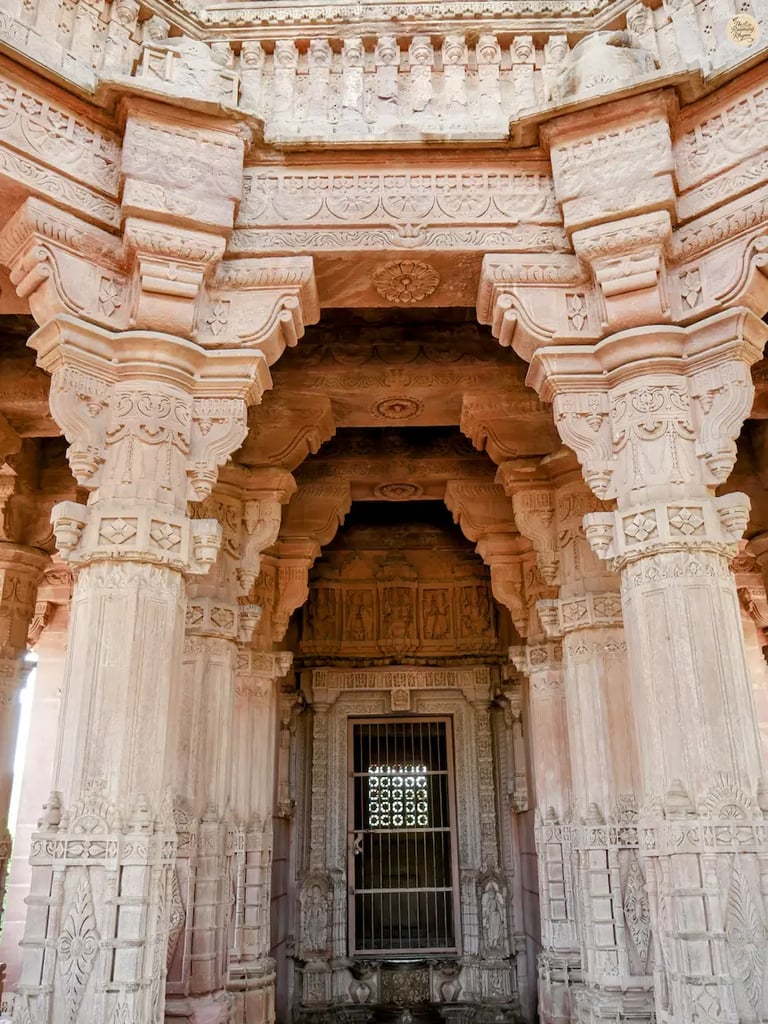

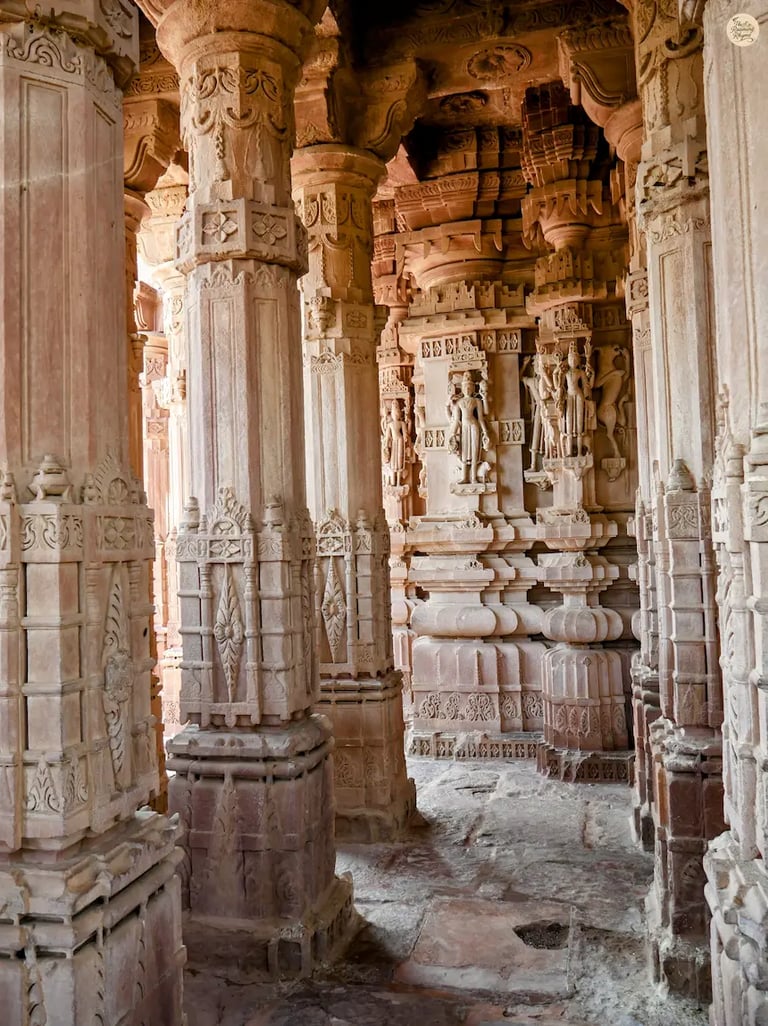

Mandore’s artistry frozen in time.
Stone stories carved with grace inside Mandore Garden’s ancient temple.
Every curve and carving in Mandore whispers the art of a timeless era.

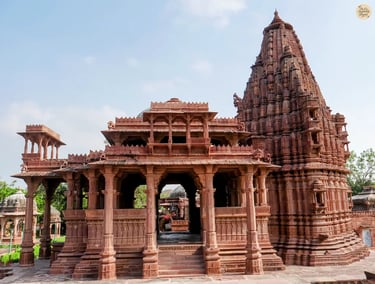
Beautiful ancient temple inside Mandore Garden, showcasing Jodhpur’s heritage and historic architecture.
Sunset from Pachetia Hills – Best City Views
After wandering the history-soaked paths of Mandore Garden, trade the ancient calm for a hilltop view that captures Jodhpur in its most magical light — the sunset from Pachetia Hills.
A short, scenic climb takes you along the Blue Corridor, where narrow lanes bloom with vibrant Rajasthani murals and street art. You can choose the winding staircase or the slightly steeper path via the Panchmukhi Hanuman Temple — both lead to the same reward in just 5–10 minutes.
At the summit, the Blue City unfurls beneath you like a painted tapestry — Mehrangarh Fort glowing like molten gold, Umaid Bhawan Palace glimmering in the distance, and blue rooftops blushing under the day’s last light. Small rooftop cafés serve steaming chai, hot Maggi, and snacks — perfect companions while you watch the horizon transform into a canvas of orange, pink, and purple.
As dusk deepens and city lights twinkle, it feels as though Jodhpur has wrapped you in a warm Rajasthani shawl — colourful, intricate, and unforgettable.
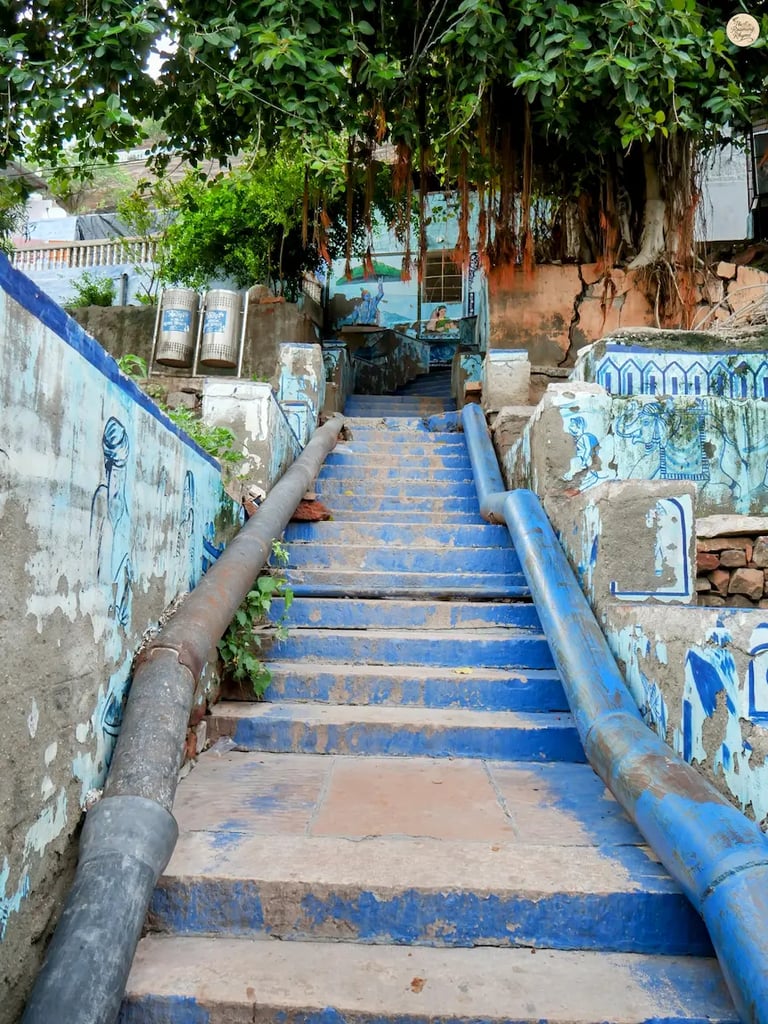

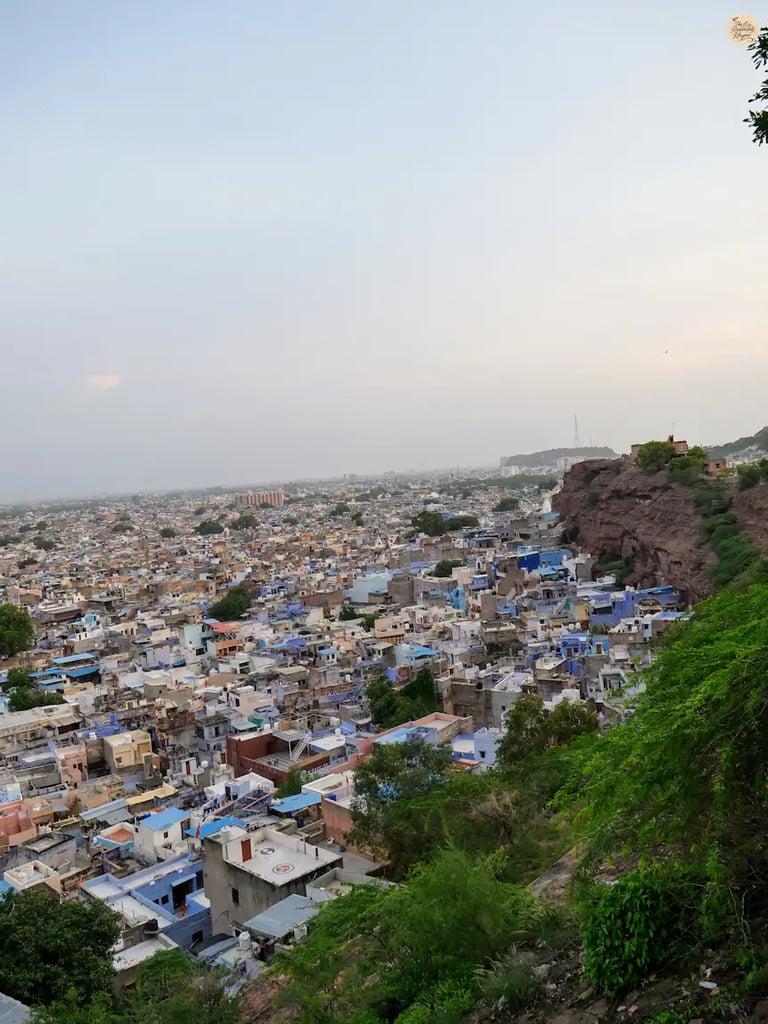


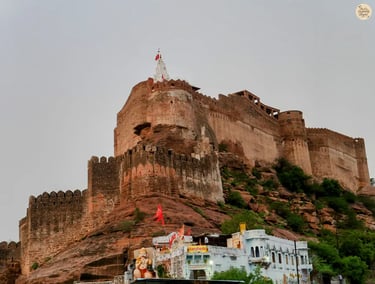

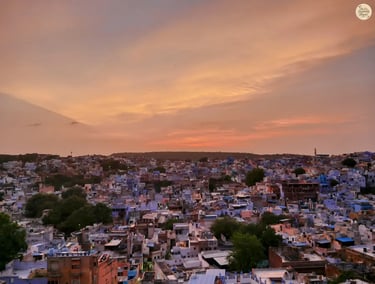
Mehrangarh Fort — the Blue City’s timeless guardian as seen from Pachetia Hill.
Sunset paints the Blue City of Jodhpur in golden light from Pachetia Hill.
Steps of the Blue Corridor – where painted walls guide you to Jodhpur’s golden sunset at Pachetia Hill.
Endless blue houses of Jodhpur seen from Pachetia Hill’s height.
Best Photography Spots in Jodhpur
If you love photography, Jodhpur is a dream in every shade of blue and gold. For sunrise shots, head to the Blue Lanes around Navchowkiya and City Police Chowki — the quiet mornings give you perfect light and empty alleys. At sunset, Pachetia Hills offers sweeping views of the Mehrangarh Fort glowing golden above the blue rooftops.
Inside Mehrangarh Fort itself, the Sheesh Mahal and Phool Mahal are treasures of light and color, while the Chamunda Mata Temple offers panoramic shots of the city. Don’t miss the reflection views at Toorji Ka Jhalra Stepwell, especially in the late afternoon when the honeyed light makes the stone glow.
For something grand, the Umaid Bhawan Palace lawns are unbeatable, and for street-style captures, the Clock Tower Market, with its spices, textiles, and bustling energy, is full of vibrant frames. Pro tip: Always ask before clicking portraits of locals, and you’ll often be rewarded with genuine smiles that make your photos even richer.
Jodhpur is more than a destination — it’s a living canvas of blue-painted houses, golden fortresses, royal palaces, and desert winds. Every lane hums with folk songs, every wall holds a story, and every sunset feels like it was painted just for you.
From the towering Mehrangarh Fort to the peaceful corners of Mandore Garden, from the grandeur of Umaid Bhawan Palace to the comforting warmth of a Rajasthani thali, Jodhpur blends royal opulence with soulful charm.
In this journey with The Roaming Rhyme, the city revealed itself in indigo lanes, royal halls, and hilltop horizons — each step adding a verse to Jodhpur’s living poem. Whether you came for history, flavours, or the sky’s changing colours, the Blue City finds a way to slow you down and make you feel at home.
And when you finally leave, its colours follow you — the soft blues of its houses, the golden glow of its sunsets, and the warm reds of its people’s hearts. Until your footsteps return to these desert streets, let Jodhpur’s spirit travel with you — in your memories, your photographs, and the stories you’ll share again and again.
If Jodhpur left you spellbound, you’ll love exploring more — from Bikaner’s desert forts to Orchha’s palaces, and from Khajuraho’s temple artistry to Hampi’s royal ruins. Each city adds a new verse to India’s timeless story.
Frequently Asked Questions – Jodhpur Travel Guide
Q. How many days are enough to explore Jodhpur?
A. Two full days are ideal for a first-time visitor. This gives you enough time to explore Mehrangarh Fort, Jaswant Thada, Umaid Bhawan Palace, Mandore Garden, the Blue Lanes, local markets, and sunset spots without rushing. If you want to experience nearby places like the Osian desert or Bishnoi villages, add an extra day.
Q. What is the best time to visit Jodhpur?
A. The best time to visit Jodhpur is October to March, when the weather is cool and pleasant for sightseeing. Summers (April–June) can get extremely hot, while monsoons (July–September) bring occasional showers and lush views.
Q. Why is Jodhpur called the Blue City?
A. Jodhpur earned the name Blue City of Rajasthan because many of its old houses, especially in the area around Mehrangarh Fort, are painted in shades of blue. Originally, the Brahmin community (priests) painted their homes blue to distinguish themselves from others. Over time, the trend spread across the city, turning the skyline into a sea of indigo.
Q. What food should I try in Jodhpur?
A. Don’t miss mirchi vada and pyaaz kachori at Jalori Gate, makhaniya lassi at Shri Mishrilal Hotel, malai roti & gulab jamun ki sabzi at Vijay Restaurant, and the royal Rajasthani thali at Gypsy Restaurant. For dinner with a view, try rooftop cafés near the fort.
Q. Is Jodhpur safe for solo travelers?
A. Yes, Jodhpur is considered safe for solo and female travelers. The locals are friendly and helpful. Just follow basic precautions — avoid deserted lanes late at night, dress modestly when visiting temples, and keep belongings secure in crowded markets.
Q. What are the best shopping places in Jodhpur?
A. The best markets are Clock Tower Market & Sardar Market (spices, handicrafts), Sojati Gate (bandhani fabrics), Mochi Bazaar (mojaris), Lakhara Bazaar (bangles), and Tripolia Bazaar (wooden toys, leather goods).
Q. Can I visit Jodhpur and Jaisalmer together?
A. Yes, many travelers combine Jodhpur with Jaisalmer. The distance is about 280 km (5–6 hours by road or train). Spend 2–3 days in Jodhpur and then head to Jaisalmer for desert safaris, sand dunes, and fort experiences.
Q. Are there desert safaris in Jodhpur?
A. While Jodhpur itself is known more for forts and palaces, you can take short desert village tours to Osian (65 km away) for camel rides, jeep safaris, and temple visits. For vast sand dunes, Jaisalmer is the better choice.
Q. What are some offbeat things to do in Jodhpur?
A. Beyond the main attractions, try:
Visiting the Rao Jodha Desert Rock Park near Jaswant Thada.
Watching a folk music & dance show at a haveli.
Taking a Bishnoi Village Safari to learn about rural life and traditional crafts.
Q. What souvenirs should I buy from Jodhpur?
A. Popular souvenirs include Bandhani (tie-dye) fabrics, mojari shoes, wooden puppets, spices, antique handicrafts, leather bags, and silver jewelry. The Clock Tower & Sardar Market are the best spots for authentic shopping.
Q. Is photography allowed inside Jodhpur’s forts and palaces?
A. Yes, photography is allowed in most places, including Mehrangarh Fort and Umaid Bhawan Palace Museum, though some sections may charge a camera fee (₹100–200). Always check signs at entry gates for restrictions.
Q. Why is Jodhpur painted blue?
A. The blue paint wasn’t just for looks — it had a purpose. The natural indigo tint mixed in lime plaster is believed to keep homes cooler in Rajasthan’s desert heat, repel termites, and add a spiritual calm. Today, while not every house is blue, the tradition lives on, giving Jodhpur its iconic charm and photogenic beauty.
Share Your Thoughts – We’d Love to Hear From You!
Every journey is better when shared.
We hope you enjoyed this travel story — now, we'd love to hear yours! Share your experience, suggestions, or feedback and help us make our travel tales even better.
